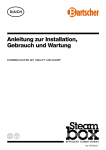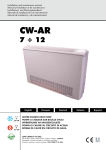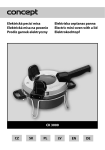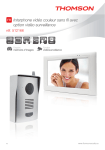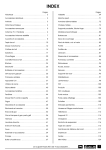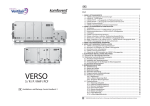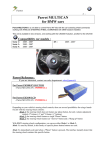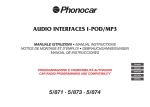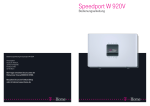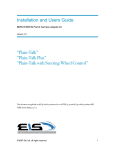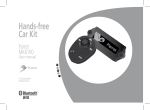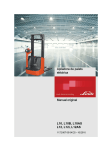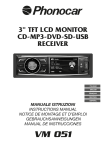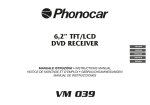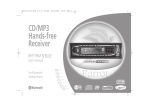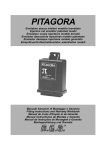Download Steering wheel mounted control Parrot MULTICAN
Transcript
Steering wheel mounted control Parrot MULTICAN ® For Parrot Bluetooth CK3000 EVOLUTION CK3100 LCD hands-free car kits User Guide Parrot MULTICAN • English.................................................................3 • Français................................................................19 • Español................................................................35 • Italiano.................................................................51 • Deutsch................................................................67 English Français Español Italiano Deutsch CONTENTS • • • • • • • • • • INTRODUCTION ........................................................................... 5 KIT CONTENTS ............................................................................. 5 FITTING ........................................................................................ 5 VEHICLE SPECIFIC FITTING PROCEDURE ...................................... 8 CHECKING THE WIRING ................................................................15 FIRST TIME USE ............................................................................ 15 FEATURES ..................................................................................... 15 REINSTALLING THE PARROT MULTICAN IN A DIFFERENT CAR ..................... 18 HOTLINE ....................................................................................... 18 GENERAL INFORMATION ............................................................. 83 Note : In the rest of this guide, the abbreviation «SWC» will be used to replace the term «steering wheel controls». Parrot draws on its long years of experience in the Bluetooth technology and signal processing to offer you innovative hands-free kits. Fitting the Steering Wheel Control (SWC) Interface: KIT CONTENTS • Installation cables - Power supply cable for the interface - Parrot CK3000 EVOLUTION control keypad adapter (available depending on your product’s model) - Parrot CK3100 LCD screen adapter (available depending on your product’s model) - Bullet terminal female • Directions for use On some vehicles, the 12V power wires may be reversed, in which case you must reverse the red and orange wires of the hands-free kit’s power supply. This can easily be done by reversing the two fuse holders on the kit’s power cable. Ensure that the orange wire is used for the ignition +12V. Otherwise, you might run down the vehicle’s battery. You must therefore connect the orange power wire to the fuse box or another ignition power source. Deutsch Italiano The power supply for the Parrot MULTICAN interface is taken from the power cable of the Parrot hands-free kit. It is important to follow the colour code of the power cable wires: - The red wire of the kit’s cable corresponds to the permanent 12V supply - The orange wire corresponds to the ignition 12V (usually supplied by Parrot Multican) - The black wire is for ground - The yellow wire corresponds to the Parrot mute output Español Thank you for purchasing this steering wheel control interface designed for the Parrot CK3100 LCD and Parrot CK3000 EVOLUTION hands-free kits. The Parrot MULTICAN interface enables you to connect your vehicle’s steering wheel controls (SWC) to your Parrot hands-free kit. With this interface, you will be able to make phone calls via the steering wheel controls while keeping your hands on the wheel. Français This fitting guide only describes the procedure for fitting the Parrot MULTICAN steering wheel control interface. Do not hesitate to refer to the directions for use supplied with your hands-free kit for further information on the fitting procedure. We would advise our customers to have the interface fitted by a professional. The Bluetooth wireless technology enables voice and data to be sent via a short-distance radio link. It allows several electronic devices to communicate with each other, particularly phones and hands-free kits. English FITTING INTRODUCTION CK3100 Parrot CK3000 EVOLUTION 2 Join the connector of the kit’s control keypad to the connector on the interface’s power cable. 3 K- Bus 3 Connect the Parrot MULTICAN interface’s power cable to the Parrot control unit and to the power cable of the hands-free kit. 3 1 4 2 Mute 2 Parrot CK3000 EVOLUTION Parrot 1 Connect the power cable of the Parrot MULTICAN interface to the 14-way connector of the Parrot MULTICAN unit. 5 Can High Can Low 5 4 Connect the yellow mute wire of the Parrot MULTICAN interface: - To the Parrot yellow mute wire - And to the car stereo’s mute input if applicable 5 Refer to the chapter entitled «Vehicle Specific Fitting Procedure» to correctly connect the CAN protocol. Attention: DON’T DIRECTLY CONNECT THE ORANGE WIRE OF THE PARROT H/F KIT TO THE IGNITION + 15 . THIS FUNCTION IS ALREADY SUPPLIED BY Parrot MULTICAN UNIT. English Parrot CK3100 LCD K- Bus Can High Can Low 1 Connect the power cable of the Parrot MULTICAN interface to the 14-way connector of the Parrot MULTICAN unit. 3 2 Join the connector of the kit’s control keypad to the connector on the interface’s power cable. 1 1 2 Mute 3 Connect the Parrot MULTICAN interface’s power cable to the Parrot control unit and to the power cable of the hands-free kit. 4 3 Parrot CK3100 LCD 5 Refer to the chapter entitled «Vehicle Specific Fitting Procedure» to correctly connect the CAN protocol. 2 Italiano 4 Connect the yellow mute wire of the Parrot MULTICAN interface: - To the Parrot yellow mute wire - And to the car stereo’s mute input if applicable Español Parrot 5 Français 5 2 Car stereo with ISO connectors: Deutsch Attention: DON’T DIRECTLY CONNECT THE ORANGE WIRE OF THE PARROT H/F KIT TO THE IGNITION + 15 . THIS FUNCTION IS ALREADY SUPPLIED BY Parrot MULTICAN UNIT. Vehicle Specific Fitting Procedure Important : Remove the audio and power ISO connectors from your car stereo and plug the male ISO connectors of the hands-free kit into the car stereo. Connect the vehicle’s audio and power ISO connectors to the female ISO connectors of your hands-free kit. If the car stereo features a mute input, connect the yellow wire of the kit’s cable to the car stereo’s mute input. Check the position of your car stereo’s mute input before connecting the yellow wire. If necessary, test the three possible inputs and then select the one corresponding to the mute input. The wires corresponding to the CAN protocol must be connected correctly to your car stereo’s CAN information. It is important to follow the wiring diagram for your vehicle. We would advise our customers to have the interface fitted by a professional. ATTENTION: DON’T DIRECTLY CONNECT THE ORANGE WIRE OF THE PARROT H/F KIT TO THE IGNITION + 15. THIS FUNCTION IS ALREADY SUPPLIED BY PARROT MULTICAN UNIT. Car stereo without ISO connectors: If your car stereo does not feature ISO connectors, an ISO adapter cable can be used to simplify the installation of your hands-free kit and your steering wheel control interface. The ISO adapter can then be used to connect your hands-free kit by adapting to your vehicle’s specific connections. You will find a list of adapter cables on our website at www.parrot.com for simplifying the installation procedure. If the car stereo features a mute input, connect the yellow wire of the kit’s cable to the car stereo’s mute input. Check the position of your car stereo’s mute input before connecting the yellow wire. If necessary, test the three possible inputs and then select the one corresponding to the mute input. Our www.parrot.com website contains a complete, up-to-date base of wiring diagrams for all Parrot products, specifically covering every make and model. Note : Bullet terminal female are supplied with the Parrot MULTICAN interface to simplify the installation of the dedicated CAN protocol wires. If the purple wire (corresponding to the K-Bus) of the power cable is not used, you are advised to cut off the male metal contact and insulate the wire to prevent it from shorting with the car’s bodywork. English Alfa Romeo PSA A - CAN configuration : Can High Parrot K-bus • Connect the green wire corresponding to CAN High to pin 5. • Connect the white wire corresponding to CAN Low to pin 6. Alfa Romeo connector Audi Volsvagen opel Audi Español Français Can Low A - CAN configuration : Italiano Can High Can Low Parrot • Connect the green wire corresponding to CAN High to pin 9. • Connect the white wire corresponding to CAN Low to pin 10. Audi connector Deutsch K-bus BMW BMW BMW A - CAN configuration : M M Can High Can Low Parrot K-bus BMW connector • Connect the green wire corresponding to CAN High to pin 11. • Connect the white wire corresponding to CAN Low to pin 9. PS PS A - K-Bus configuration Can High Can Low Parrot K-bus BMW connector • Connect the purple wire corresponding to K-Bus to pin 9. 10 Audi Volsvagen opel Audi Volsvagen opel English Chrysler A - CAN configuration : Can High Parrot 6 5 Chrysler connector • Connect the green wire corresponding to CAN High to pin 5. • Connect the white wire corresponding to CAN Low to pin 6. 1 BMW Mercedes Italiano Can High Can Low K-bus • Connect the green wire corresponding to CAN High to pin 11. • Connect the white wire corresponding to CAN Low to pin 9. Mercédes connector 11 Deutsch Mer 2 A - CAN configuration : Parrot Español K-bus Français Can Low PSA Fiat PSA A - CAN configuration : Can High Can Low Parrot K-bus • Connect the green wire corresponding to CAN High to pin 5. •Connect the white wire corresponding to CAN Low to pin 6. Fiat connector Audi Volsvagen opel Volkswagen A - CAN configuration : Can High Can Low Parrot K-bus • Connect the green wire corresponding to CAN High to pin 9. • Connect the white wire corresponding to CAN Low to pin 10. Volkswagen connector 12 Audi Volsvagen opel A - CAN configuration : English Opel Can High Parrot K-bus • Connect the green wire corresponding to CAN High to pin 9. • Connect the white wire corresponding to CAN Low to pin 10. Opel connector Renault 6 5 Español Français Can Low A - CAN configuration : Can Low Parrot 1 K-bus Italiano Can High 2 •Connect the green wire corresponding to CAN High to pin 2. •Connect the white wire corresponding to CAN Low to pin 1. 13 Deutsch Renault connector Citroën BMW A - CAN configuration : PSA Mercedès Can High Can Low Parrot K-bus • Connect the green wire corresponding to CAN High to pin 10. • Connect the white wire corresponding to CAN Low to pin 13. Peugeot Audi Volsvagen opel Citroën connector PSA A- CAN configuration : Can High Can Low Parrot K-bus • Connect the green wire corresponding to CAN High to pin 10. • Connect the white wire corresponding to CAN Low to pin 13. Audi Volsvagen opel 14 Peugeot connector Once your Parrot MULTICAN interface has been correctly fitted, the interface’s LED should light up green, in which case the interface is ready for use. You can now use most of the features of your hands-free kit via the Parrot MULTICAN interface. FEATURES Depending on the steering wheel controls in your vehicle, the Parrot MULTICAN interface will enable you to take full advantage of the features available on your hands-free kit: It is also important to check the wiring of your hands-free kit. In this case, refer to the user guide supplied with your kit. FIRST TIME USE The first time that you switch on your hands-free kit, you must pair your mobile phone with the kit. This phase involves configuring the Bluetooth connection between your phone and the hands-free kit. Depending on your vehicle’s steering wheel controls, there are several possibilities for using a hands-free kit with the steering wheel controls: Pairing your phone with your hands-free kit: • Mode 1 : the steering wheel does not feature any phone button, but only volume adjustment controls («Volume (+)» and «Volume (–)» buttons) • Mode 2 : the steering wheel features a single «Phone» button • Mode 3 : the steering wheel features an «Answer» button and a «Hang up» button 15 Deutsch • Ensure that the Bluetooth feature on your phone is enabled • Search for Bluetooth peripherals on your phone (refer to your phone’s user guide or visit the Support heading on our website at www.parrot.com) • Select your hands-free kit • Enter «1234» on your phone when prompted • Both devices connect automatically Italiano Some vehicles come with specific «Answer / Hang up» buttons for using a phone from the steering wheel. The hands-free kit can also be used via the volume adjustment buttons. Note : you can skip the following phase if your phone is already paired with your handsfree kit. Español • Receive a call • End a call • Redial function • Call volume adjustment • Contacts phoned using the kit’s voice recognition feature • Volume adjustment during calls • Language setting (Only for Parrot CK3000 EVOLUTION) • Menu navigation (Only for Parrot CK3000 EVOLUTION) Français If the LED does not light up, check the power wires of your Parrot MULTICAN interface. - The red power wire should correspond to the permanent +12V. - The orange power wire should correspond to the ignition +12V. - The yellow wire of the Parrot MULTICAN interface should be connected to the yellow Mute wire of the Parrot hands-free kit and to the Mute input on your car stereo (if your car stereo features a mute input). English Note : refer to the «Support» heading on our website at www.parrot.com for further information. Checking the Wiring Mode 1 :Using with the volume adjustment buttons • Answer an incoming call: Press the «Volume (+)» button. Volume + / - SWC Configuration 1 phone button • End a call: Press the «Volume (-)» button. 2 phone buttons • Refuse an incoming call: Press the «Volume (-)» button. • Start the voice recognition feature: Press the «Volume (+)» button, then quickly press the «Volume (-)» button. • Redial the last number: Quickly press the «Volume (+)» button, followed by a long press of the «Volume (-)» button until the number is dialled. • Discreet mode: Quickly press the «Volume (+)» button. Mode 1 OK OK OK • Exit discreet mode: During the call, quickly press the «Volume (+)» button followed by Mode 2 «Volume (-)». •Increase the volume: During the call, press the «Volume (+)» button and then on the OK OK «Volume (-)» button. Repeat this procedure until you reach the required volume. Mode 3 • Lower the volume: During the call, press the «Volume (-)» button and then on the OK «Volume (+)» button. Repeat this procedure until you reach the required volume. • Enter the menu: Press the following sequence twice: «SEEK up» button then the By default, the steering wheel control interface starts in mode 1, i.e the steering wheel does not have specific phone buttons. «SEEK down» button.The SEEK buttons are used to search for radio stations. When the «Phone» button is pressed, the interface immediately switches to mode 2. The interface instantly understands that the steering wheel contains a specific button for phoning. • Go forward through the menu: Press the «Volume (+)» button then the «Volume (-)» button, leaving less than one second between each press. When the «Hang up» button is pressed, the interface understands that there are two phone buttons and instantly switches to mode 3. Once the mode has been selected, the interface remains in that mode. • Go backwards through the menu: Press the «Volume (-)» button then the «Volume (+)» button, leaving less than one second between each press. • Select a menu option: Quickly press the «Volume (+)» button. • Cancel a menu option: Quickly press the «Volume (-)» button. • Reset the hands-free kit: Repeat the following sequence five times: press the «Volume (–)» button and then the «Volume (+)» button. 16 Mode 3 : Using with two phone buttons • End a call: Press the «Hang up» button. • Refuse an incoming call: Long press of the «Phone» button. • Start the voice recognition feature: Quick press of the «Answer» button. • Start the voice recognition feature: Short press of the «Phone» button. • Redial the last number: Long press of the «Answer» button. • Redial the last number: Long press of the «Phone» button. • Discreet mode: Quick press of the «Answer» button. • Discreet mode: Press the «Phone» button. • Exit discreet mode: Quick press of the «Answer» button. • Exit discreet mode: Press the «Phone» button. • Increase the volume: During the call, press the «Volume (+)» button until you reach the • Increase the volume: During the call, press the «Volume (+)» button . Repeat this required volume. • Lower the volume: During the call, press the «Volume (-)» button until you reach the procedure until you reach the required volume. • Lower the volume: During the call, press the «Volume (-)» button. Repeat this procedure required volume. • Enter the menu: Press the following sequence twice: «SEEK up» button then the «SEEK until you reach the required volume. down» button.The SEEK buttons are used to search for radio stations. down» button.The SEEK buttons are used to search for radio stations. • Go forward through the menu: Press the «Volume (+)» button. • Go forward through the menu: Press the «Volume (+)» button. • Go backwards through the menu: Press the «Volume (-)» button. • Go backwards through the menu: Press the «Volume (-)» button. • Select a menu option: Quickly press the «Answer» button. • Select a menu option: Quickly press the «Phone» button. • Cancel a function: Quickly press the «Hang up» button. • Cancel a function: Long press of the «Phone» button. • Reset the hands-free kit: Repeat the following sequence five times: press the «Volume • Reset the hands-free kit: Repeat the following sequence five times: press the «Volume Italiano • Enter the menu: Press the following sequence twice: «SEEK up» button then the «SEEK Español • Answer an incoming call: Press the «Answer» button. • End a call: Long press on the «Phone» button. Français • Answer an incoming call: Press the «Phone» button. English Mode 2 : Using with a single phone button (-)» button and then the «Volume (+)» button. Deutsch (-)» button and then the «Volume (+)» button. 17 HOTLINE REINSTALLING THE PARROT MULTICAN IN A DIFFERENT CAR Once installed into a car, the unit will keep the CANBUX Protocol memorized. Our hotline is at your disposal. You can contact us by email or telephone. Open from Monday to Friday between 9 am and 6 pm (GMT+1). Visit our website at www.parrot.com for further information. Warning: Make sure the ignition is turned off. Italy: [+39] 02 86 39 14 63 Spain: [+34] 902 404 202 UK: [+44] (0)870 112 5872 Germany: 0900 172 77 68 USA: [+1] (877) 9 PARROT (toll-free) China: [+86] (0)2164 601 944 Hong Kong: [+852] 2736 1169 France: 01 48 03 60 69 Europe: [+33] 1 48 03 60 69 (languages spoken: English, French, Spanish and German). 1. Install the Parrot MULTICAN in the new car. 2. With ignition off, wait till the GREEN led switches off. 3. Press the Multican button until the green LED switches on, then switches off. LED Reset 4. Release the Multican button. > The LED blinks in red. 5. Turn on the ignition. > The Multicolour LED lights up in green. > The new CANBUS protocol is selected. 18 English Français Español Italiano Deutsch 19 SOMMAIRE • INTRODUCTION ......................................................................... 21 • CONTENU DE L’EMBALLAGE ...................................................... 21 • INSTALLATION ........................................................................... 21 • INSTALLATION SPÉCIFIQUE À LA VOITURE ................................ 24 • VÉRIFICATION DE L’INSTALLATION ............................................ 31 • PREMIÈRE UTILISATION ............................................................. 31 • FONCTIONNALTÉS ..................................................................... 31 • REINSTALLER LE MULTICAN DANS UNE VOITURE DIFFERENTE ................. 34 • HOTLINE .................................................................................... 34 • INFORMATION GÉNÉRALE ......................................................... 83 20 Note : Dans la suite de ce document le terme « commandes au volant » sera remplacé par CAV. Parrot tire bénéfice de ses longues années d’expérience dans la technologie Bluetooth et dans le traitement du signal pour vous proposer des kits mains-libres innovants. CONTENU DE L’EMBALLAGE • Câbles d’installation - Câble d’alimentation pour l’interface. - Adaptateur clavier de commande Parrot CK3000 EVOLUTION (disponibilité selon le modèle de votre produit) - Adaptateur écran LCD CK3100 (disponibilité selon le modèle de votre produit) - Cosses femelle • Notice d’utilisation. Sur certains véhicules, les tensions d’alimentation peuvent être inversées et il est alors nécessaire d’inverser les fils rouge et orange de l’alimentation du kit mains-libres. Cette opération s’effectue simplement en inversant les deux portes fusibles du câble d’alimentation du kit. Vérifiez bien que le fil orange correspond au +12V après contact. Dans le cas contraire vous risqueriez de décharger la batterie du véhicule. Dans le cas contraire, il est alors nécessaire de brancher le fil d’alimentation orange sur la boite à fusible ou sur une autre source d’alimentation après contact. 21 Deutsch Italiano L’alimentation de l’interface Parrot MULTICAN est réalisée par une dérivation de l’alimentation du kit mains-libres Parrot. Il est important de suivre le code couleur des tensions d’alimentation : - Le fil rouge du câble du kit doit correspondre au +12V permanent - Le fil orange doit correspondre au 12V après-contact (cette fonction est d’habi- tude réalisée par le Parrot MULTICAN) - Le fil noir à la masse. - Le fil jaune correspond à la sortie Mute Parrot Español Installation de l’interface Commandes aux volants (CAV) : Merci d’avoir acheté cette interface commande au volant pour les kits mains-libres Parrot : Parrot CK3100 LCD et Parrot CK3000 EVOLUTION. L’interface Parrot MULTICAN vous permet de relier les commandes aux volants (CAV) de votre véhicule aux kits mains-libres Parrot. Avec cette interface vous allez pouvoir passer des appels téléphoniques en utilisant les boutons commandes de votre volant tout en gardant les mains sur le volant. Français Cette notice d’installation concerne uniquement le montage de l’interface commande au volant Parrot MULTICAN. N’hésitez pas à consulter la notice d’utilisation de votre kit mains-libres pour avoir un complément d’information sur l’installation. Pour cette installation, nous recommandons à nos clients de faire appel à un professionnel de l’automobile. La technologie Bluetooth permet d’établir des communications voix et données via une liaison radio courte distance. Elle permet à de nombreux équipements électroniques de communiquer entre eux, notamment les téléphones et les kits mains-libres. English INSTALLATION INTRODUCTION CK3100 Parrot CK3000 EVOLUTION 2 Connectez le clavier de commande au câble d’alimentation de l’interface. 3 K- Bus 3 Connecter le câble d’alimentation de l’interface Parrot MULTICAN sur le boitier Parrot et sur le câble Power du carkit Parrot. 3 1 4 2 Mute 2 Parrot CK3000 EVOLUTION Parrot 1 Connectez le câble d’alimentation de l’interface Parrot MULTICAN au connecteur 14 voies du boitier Parrot MULTICAN. 5 Can High Can Low 5 4 Connecter le fil jaune Mute de l’interface Parrot MULTICAN - au fil jaune du câble mute Parrot - et à l’entrée mute de l’autoradio si votre système audio possède cette entrée. 5 Consultez le chapitre « Installation spécifique à la voiture » afin de respecter le branchement du protocole CAN. 22 ATTENTION : NE PAS RELIER DIRECTEMENT LE FIL ORANGE DU KIT PARROT A UNE TENSION APRES CONTACT « + 15 ». CETTE FONCTION EST DEJA REALISEE PAR LE PARROT MULTICAN English Parrot CK3100 LCD 5 K- Bus Can High Can Low 3 2 Connectez le clavier de commande au câble d’alimentation de l’interface. 3 Connecter le câble d’alimentation de l’interface Parrot MULTICAN sur le boitier Parrot et sur le câble Power du carkit Parrot. 1 1 2 Mute 4 Parrot CK3100 LCD 5 Consultez le chapitre « Installation spécifique à la voiture » afin de respecter le branchement du protocole CAN. 2 2 23 ATTENTION : NE PAS RELIER DIRECTEMENT LE FIL ORANGE DU KIT PARROT A UNE TENSION APRES CONTACT « + 15 ». CETTE FONCTION EST DEJA REALISEE PAR LE PARROT MULTICAN Deutsch Italiano 4 Connecter le fil jaune Mute de l’interface Parrot MULTICAN - au fil jaune du câble mute Parrot - et à l’entrée mute de l’autoradio si votre système audio possède cette entrée. 3 Español Parrot 1 Connectez le câble d’alimentation de l’interface Parrot MULTICAN au connecteur 14 voies du boitier Parrot MULTICAN. Français 5 Installation spécifique à la voiture Autoradio avec connecteur ISO : Important : Retirez les connecteurs ISO audio et alimentation de votre autoradio et remplacez les par les connecteurs ISO male du kit mains-libres sur l’autoradio. Reliez les connecteurs ISO audio et d’alimentation du véhicule aux connecteurs ISO femelle de votre kit mains-libres. Si l’autoradio est équipé d’une entrée Mute, reliez le fil jaune du câble du kit à l’entrée Mute de l’autoradio. Vérifier la position de l’entrée mute de votre autoradio avant de brancher le fil jaune. Testez au besoin les 3 entrées possible et sélectionnez celle correspondante au mute. Les fils correspondant au protocole CAN doivent être correctement branché sur les informations CAN de votre système radio Il est donc important de suivre le schéma d’installation correspondant à votre véhicule. Nous recommandons à nos clients de faire appel à un professionnel de l’automobile. NE PAS RELIER DIRECTEMENT LE FIL ORANGE DU KIT PARROT A UNE TENSION APRES CONTACT « + 15 ». CETTE FONCTION EST DEJA REALISEE PAR LE PARROT MULTICAN. Autoradio sans connecteurs ISO : Sur notre site Internet www.parrot.com , vous trouverez une liste de compatibilité voiture complète et récente des schémas d’installations pour tous les produits Parrot. Si votre autoradio ne possède pas de connecteur ISO, un câble adaptateur ISO peut être utilisé afin de faciliter l’installation de votre kit mains-libres et de votre interface commande au volant. L’adaptateur ISO permet alors de brancher votre kit mains-libres en s’adaptant à la connectique spécifique de votre véhicule. Vous trouverez sur notre site Internet la liste des faisceaux adaptateur permettant de faciliter l’installation : www.parrot.com Si l’autoradio est équipé d’une entrée Mute, reliez le fil jaune du câble du kit à l’entrée Mute de l’autoradio. Vérifier la position de l’entrée mute de votre autoradio avant de brancher le fil jaune. Testez au besoin les 3 entrées possible et sélectionnez celle correspondante au mute. Note : Des cosses femelles sont livrées avec l’interface Parrot MULTICAN afin de faciliter l’installation des fils dédiés au protocole CAN. Si le fil violet (correspond au K-Bus) du câble d’alimentation n’est pas utilisé, il est recommandé de couper le cosse métallique male afin qu’il ne soit pas en contact avec un élément de la voiture. 24 English Alfa Romeo PSA A- Installation de la configuration CAN : Can High Parrot K-bus • Connecter le fil vert correspondant au CAN High sur la voie 5. • Connecter le fil Blanc correspondant au CAN Low sur la voie 6. Connecteur Alfa Romeo Audi Volsvagen opel Audi Español Français Can Low A-Installation de la configuration CAN Italiano Can High Can Low Parrot • Connecter le fil vert correspondant au CAN High sur la voie 9. • Connecter le fil Blanc correspondant au CAN Low sur la voie 10. Connecteur Audi 25 Deutsch K-bus BMW BMW BMW A-Installation de la configuration CAN M M Can High Can Low Parrot K-bus Connecteur BMW • Connecter le fil vert correspondant au CAN High sur la voie 11. • Connecter le fil Blanc correspondant au CAN Low sur la voie 9. PS PS A- Installation de la configuration K-Bus Can High Can Low Parrot K-bus Connecteur BMW • Connecter le fil violet correspondant au K-Bus sur la voie 9. 26 Audi Volsvagen opel Audi Volsvagen opel English Chrysler A-Installation de la configuration CAN Can High Parrot 6 5 Connecteur Chrysler • Connecter le fil vert correspondant au CAN High sur la voie 5. • Connecter le fil Blanc correspondant au CAN Low sur la voie 6. 1 BMW Mercedes Italiano Can High Can Low K-bus • Connecter le vert jaune correspondant au CAN High sur la voie 11. • Connecter le fil Blanc correspondant au CAN Low sur la voie 9. Connecteur Mercedes 27 Deutsch Mer 2 A-Installation de la configuration CAN Parrot Español K-bus Français Can Low PSA Fiat PSA A-Installation de la configuration CAN Can High Can Low Parrot K-bus • Connecter le fil vert correspondant au CAN High sur la voie 5. • Connecter le fil Blanc correspondant au CAN Low sur la voie 6. Connecteur Fiat Audi Volsvagen opel Volkswagen A-Installation de la configuration CAN Can High Can Low Parrot K-bus Can High • Connecter le fil vert correspondant au CAN High sur la voie 9. Can Low • Connecter le fil Blanc correspondant au CAN Low sur la voie 10. K-bus Parrot Connecteur Volkswagen 28 Audi Volsvagen opel A-Installation de la configuration CAN English Opel Can High Parrot K-bus • Connecter le fil vert correspondant au CAN High sur la voie 9. • Connecter le fil Blanc correspondant au CAN Low sur la voie 10. Connecteur Opel Renault 6 5 Español Français Can Low A-Installation de la configuration CAN Can Low Parrot 1 K-bus Italiano Can High 2 • Connecter le fil vert correspondant au CAN High sur la voie 2. • Connecter le fil Blanc correspondant au CAN Low sur la voie 1. 29 Deutsch Connecteur Renault Citroën BMW A-Installation de la configuration CAN PSA Mercedès Can High Can Low Parrot K-bus • Connecter le fil vert correspondant au CAN High sur la voie 10. • Connecter le fil Blanc correspondant au CAN Low sur la voie 13. Peugeot Audi Volsvagen opel Connecteur Citroën PSA A-Installation de la configuration CAN Can High Can Low Parrot K-bus • Connecter le fil vert correspondant au CAN High sur la voie 10. • Connecter le fil Blanc correspondant au CAN Low sur la voie 13. 30 Audi Volsvagen opel Connecteur Peugeot Une fois, votre interface Parrot MULTICAN correctement installée, la diode de l’interface doit s’allumée en vert. Dans ce cas, l’interface est alors prête à être utilisée. Vous pouvez désormais bénéficier des fonctionnalités de votre kit mains-libres à travers vos interface Parrot MULTICAN. FONCTIONALITES Suivant les commandes aux volants que vous disposez, l’interface Parrot MULTICAN vous permet de bénéficier des fonctionnalités suivantes de votre kit mains-libres : Il est aussi important de vérifier l’installation de votre kit mains-libres, dans ce cas, veuillez consulter le manuel d’utilisation de votre kit. PREMIERE UTILISATION Lors de la première mise sous tension du votre kit mains-libres, vous devez jumeler votre téléphone avec le kit. Cette phase consiste à configurer la connexion Bluetooth entre votre téléphone et votre kit mains-libres. Selon la configuration du volant de votre véhicule, il existe plusieurs possibilités d’utiliser un carkit avec les commandes au volant : Jumelage de votre téléphone avec votre kit mains-libres : • Mode 1 : Le volant ne possède pas de bouton téléphone mais seulement les boutons de réglage du Volume (boutons « Volume + » et « Volume –» ) • Mode 2 : Le volant possède 1 bouton « décrocher / Raccrocher » • Mode 3 : Le volant possède 1 bouton « décrocher » et 1 bouton « raccrocher » 31 Deutsch • Assurez-vous que la fonction Bluetooth de votre téléphone soit activée. • Depuis votre téléphone Bluetooth, lancez une recherche de périphériques Bluetooth.(Référez-vous à la notice de votre téléphone ou connectez-vous sur www.parrot.com, rubrique Support). • Sélectionnez votre kit mains-libres. • Entrez «1234» sur votre téléphone lorsque celui-ci vous y invite. • Les deux appareils se connecteront automatiquement. Italiano Certains véhicules sont dotés de boutons spécifiques pour l’utilisation d’un téléphone à partir du volant : « Décrocher / Raccrocher » Le kit mains-libres peut aussi être utilisé à partir des boutions de réglages volume. Note : La phase suivante n’est pas nécessaire si votre téléphone était déjà jumelé à votre kit mains-libres. Español • Recevoir un appel. • Raccrocher un appel. • Fonction Bis. • Réglage volume de la communication. • Appel de contacts en utilisant la reconnaissance vocale du kit. • Réglage du volume en communication. • Réglage de la langue (Seulement pour le Parrot CK3000 EVOLUTION) • Navigation du menu (Seulement pour le Parrot CK3000 EVOLUTION) Français Si cette diode ne s’allume pas, vérifier les tensions d’alimentation de votre interface Parrot MULTICAN. - Le fil d’alimentation rouge doit avoir une tension de 12v permanent. - Le fil d’alimentation orange doit avoir une tension de 12v après contact. - Le fil jaune de l’interface Parrot MULTICAN doit être relié au Mute jaune du carkit Parrot et à l’entrée Mute de votre autoradio. (Dans le cas où votre autoradio possède une entrée mute) English Note : Veuillez consulter notre site web www.parrot.com rubrique Support pour plus d’informations. Vérification de l’installation Mode 1 :Utilisation avec boutons de réglage de volume. • Répondre a un appel entrant : Appui sur la touche « Volume (+) » Volume + / - Configuration du volant 1 bouton Téléphone • Raccrocher un appel entrant : Appui sur la touche « Volume (-) » 2 boutons Téléphone • Refuser un appel entrant : Appui sur la touche « Volume (-) » • Lancer la reconnaissance vocale : Appui sur « Volume (+) » suivi par « Volume (-) » rapidement • Appeler le dernier numéro: Appui rapide sur « Volume (+) » suivi d’un appui long sur « Volume (-) » jusqu’à que le numéro soit composé. • Mode discret : Appui rapide sur la touche « Volume (+) ». Mode 1 OK OK OK • Sortie du mode discret: Durant la conversation appui rapide sur la touche « Volume (+) » Mode 2 puis sur la touche « Volume (-) » • Augmenter le volume: Pendant la conversation appuyer sur « Volume (+) » suivi de « OK OK Volume (-) », répéter la procédure jusqu’au niveau sonore recherché. Mode 3 • Diminuer le volume: Pendant la conversation appuyer sur « Volume (-) » suivi de « OK Volume (+) », répéter la procédure jusqu’au niveau sonore recherché. • Sélectionner le menu : Appui 2 fois sur la séquence : bouton «SEEK up» puis «SEEK Par défaut, le mode de l’interface commande au volant démarre en mode 1, donc dans la configuration ou le volant n’est pas doté de boutons spécifiques pour le téléphone. Lors d’une pression sur le bouton «Téléphone», l’interface passe immédiatement en mode 2. L’interface comprend immédiatement que le volant est doté d’un bouton spécifique pour le fonctionnement d’un téléphone. Lors d’une pression sur le bouton « Raccrocher», l’interface comprend qu’il y a 2 boutons dédiés à une utilisation téléphone et passe alors immédiatement en mode 3. Une fois le mode sélectionné, l’interface reste dans ce mode. down». Les boutons SEEK sont les boutons de vos CAV vous permettant la recherche d’une station radio. • Naviguer dans le menu en avant : Appui sur le bouton « Volume (+) » puis « Volume (-) », les appuis doivent s’effectuer en moins d’une seconde. • Naviguer dans le menu en arrière : Appui sur le bouton « Volume (-) » puis « Volume (+) », les appuis doivent s’effectuer en moins d’une seconde. • Confirmer une fonction : Appui rapide sur le bouton « Volume + » • Annuler une fonction : Appui rapide sur le bouton « Volume - » • Initialiser le carkit : Répétez 5 fois la procédure d’un appui sur « Volume (–) » suivi d’un appui sur « Volume (+) » 32 Mode 3 : Utilisation avec deux boutons téléphone. • Raccrocher un appel : Appui sur la touche « Raccrocher » • Refuser un appel entrant : Appui long sur la touche « Téléphone » • Lancer la reconnaissance vocale : Appui court sur la touche « Décrocher » • Lancer la reconnaissance vocale : Appui court sur la touche « Téléphone » • Appeler le dernier numéro : Appui long sur la touche « Décrocher » • Appeler le dernier numéro : Appui long sur la touche « Téléphone » • Mode discret : Appui court sur la touche « Décrocher » • Mode discret : Appui sur la touche « Téléphone » • Sortie Mode discret : Appui court sur la touche « Décrocher » • Sortie du mode discret : Appui sur la touche « Téléphone » • Augmenter le volume : Pendant la conversation appuyer sur « Volume (+) » jusqu’au • Augmenter le volume : Pendant la conversation appuyer sur « Volume (+) » répéter la niveau sonore recherché. • Diminuer le volume : Pendant la conversation appuyer sur « Volume (-) » jusqu’au procédure jusqu’au niveau sonore recherché. • Diminuer le volume : Pendant la conversation appuyer sur « Volume (-) », répéter la niveau sonore recherché. procédure jusqu’au niveau sonore recherché. • Sélectionner le menu : Appui 2 fois sur la séquence : bouton «SEEK up» puis «SEEK • Sélectionner dans le menu : Appui 2 fois sur la séquence : bouton «SEEK up» puis «SEEK down». Les boutons SEEK sont les boutons de vos • Naviguer dans le menu en avant : Appui sur le bouton « Volume (+) ». • Confirmer une fonction : Appui rapide sur la touche « Téléphone » • Annuler une fonction : Appui long sur la touche « Téléphone » down». Les boutons SEEK sont les boutons de votre CAV vous • Naviguer dans le menu en arrière : Appui sur le bouton « Volume (-) ». • Naviguer dans le menu en avant : Appui sur le bouton « Volume (+). • Naviguer dans le menu en arrière : Appui sur le bouton « Volume (-) ». • Confirmer une fonction : Appui rapide sur la touche « Décrocher » • Annuler une fonction : Appui court sur le bouton « Raccrocher » • Initialiser le carkit : Répétez 5 fois la procédure d’un appui sur « Volume (–) » suivi d’un appui sur « Volume (+) » Italiano CAV vous permettant la recherche d’une station radio. permettant la recherche d’une station radio. Español • Répondre a un appel entrant : Appui sur la touche « Décrocher » • Raccrocher un appel : Appui long sur la touche « Téléphone » Français • Répondre a un appel entrant : Appui sur la touche « Téléphone » English Mode 2 : Utilisation avec un seul bouton téléphone. Deutsch • Initialiser le carkit : Répétez 5 fois la procédure d’un appui sur « Volume (–) » suivi d’un appui sur « Volume (+) » 33 HOTLINE REINSTALLER LE MULTICAN DANS UNE VOITURE DIFFERENTE Notre hot-line se tient à votre disposition. Vous pouvez la contacter par mail ou par téléphone. Permanence du lundi au vendredi de 9h00 à 18h00 (GMT +1). Connectez-vous sur notre site Internet www.parrot.com pour plus d’informations. Une fois installé dans la voiture, l’unité garde en mémoire le protocole CAN. Attention : Assurez-vous que le contact soit coupé. 1.Installez l’unité dans la voiture. Italie : [+39] 02 86 39 14 63 Espagne : [+34] 902 404 202 UK : [+44] (0)870 112 5872 Allemagne : 0900 172 77 68 USA : [+1] (877) 9 PARROT (appel gratuit) Chine : [+86] (0)2164 601 944 Hong Kong: [+852] 2736 1169 France : 01 48 03 60 69 Europe : [+33] 1 48 03 60 69 (langue parlée : Anglais, Français, Espagnol et Allemand). 2.Attendez jusqu’à ce que la LED verte s’allume. 3.Maintenez enfoncé le bouton Multican. > La LED verte s’allume. > Ensuite, elle s’éteint. LED Reset 4.Relâchez le bouton Multican > La LED multicolore clignote en rouge. 5.Allumez le contact > La LED multicolore devient verte. > Le nouveau protocole CAN est détecté. 34 English Français Español Italiano Deutsch 35 ÍNDICE • • • • • • • • • • INTRODUCCIÓN.......................................................................... 37 CONTENIDO DEL PAQUETE......................................................... 37 INSTALACIÓN.............................................................................. 37 INSTALACIÓN ESPECÍFICA PARA EL COCHE................................ 40 COMPROBACIÓN DE LA INSTALACIÓN....................................... 47 PRIMERA UTILIZACIÓN............................................................... 47 FUNCIONES................................................................................. 47 REINSTALAR EL MULTICAN EN UN COCHE NUEVO ........................ 50 ASISTENCIA TÉCNICA.................................................................. 50 DATOS GENERALES......................................................................83 36 Observación:En lo sucesivo, el término “mandos en el volante” se reemplazará por MEV. Parrot saca partido de sus largos años de experiencia en la tecnología Bluetooth y en el tratamiento de la señal para ofrecerle kits manos libres innovadores. Instalación de la interfaz Mandos en el Volante (MEV): CONTENIDO DEL PAQUETE - Cable de alimentación para la interfaz - Adaptador teclado de mando Parrot CK3000 EVOLUTION (disponible segun el modelo de su producto). - Adaptador pantalla Parrot CK3100 LCD. (disponible segun el modelo de su producto). - Contactos hembras. • Manual de uso Compruebe que el hilo naranja corresponde al +12V positivo bajo llave. En caso contrario, correría el riesgo de descargar la batería del vehículo. Si éste es el caso, hay que conectar el hilo de alimentación naranja a la caja de fusibles o a otra fuente de alimentación bajo llave. Deutsch • Cables de instalación En algunos vehículos, las tensiones de alimentación pueden estar invertidas, en esos casos es necesario invertir los hilos rojo y naranja de la alimentación del kit manos libres. Esta operación se efectúa simplemente invirtiendo los dos porta-fusibles del cable de alimentación del kit. Italiano La alimentación de la interfaz Parrot MULTICAN se realiza mediante una derivación de la alimentación del kit manos libres Parrot. Es importante seguir el código de color de las tensiones de alimentación: - El hilo rojo del cable del kit debe corresponder al +12V permanente - El hilo naranja al corresponde al +12V bajo llave (esta función es proveída por la unidad de Parrot MULTICAN) - El hilo negro a la masa. - El hilo amarillo corresponde a la salida Mute Parrot Español Gracias por haber adquirido esta interfaz mandos en el volante para los kits manos libres Parrot: Parrot CK3100 LCD y Parrot CK3000 EVOLUTION. La interfaz Parrot MULTICAN le permite conectar los mandos en el volante (MEV) de su vehículo a los kits manos libres Parrot. Con esta interfaz, podrá hacer llamadas utilizando los botones de mando de su volante, sin necesidad de apartar las manos del volante. Français Estas instrucciones de instalación se refieren únicamente al montaje de la interfaz mandos en el volante Parrot MULTICAN. No dude en consultar el manual de uso de su kit manos libres para obtener información complementaria sobre la instalación. Para esta instalación, recomendamos a nuestros clientes que recurran a un profesional del automóvil. La tecnología Bluetooth permite establecer comunicaciones de voz y de datos a través de una conexión de radio de corta distancia. Permite a numerosos equipos electrónicos comunicarse entre sí, en particular a los teléfonos y kits manos libres. English INSTALACIÓN INTRODUCCIÓN 37 CK3100 Parrot CK3000 EVOLUTION 2 Conecte el conector del teclado de mando del kit al cable de alimentación de la interfaz. 3 K- Bus 3 Conecte el cable de alimentación de la interfaz Parrot MULTICAN al caja Parrot y al cable Power del kit manos libres Parrot. 3 1 4 2 Mute 2 Parrot CK3000 EVOLUTION Parrot 1 Conecte el cable de alimentación de la interfaz Parrot MULTICAN al conector 14 vías de la caja Parrot MULTICAN. 5 Can High Can Low 5 4 Conecte el hilo amarillo Mute de la interfaz Parrot MULTICAN - al hilo amarillo del cable mute Parrot - y a la entrada mute del autorradio, si su sistema de audio dispone de esta entrada. 5 Consulte el capítulo “Instalación específica para el coche” con el fin de respetar la conexión del protocolo CAN. 38 ATENCIÓN: NO CONECTAR DIRECTAMENTE EL ALAMBRE ANARANJADO DEL PARROT KIT CON EL CONTACTO +15. ESTA FUNCIÓN ES YA PROVEÍDA POR EL PARROT MULTICAN. English Parrot CK3100 LCD 5 K- Bus Can High Can Low 3 2 Conecte el conector del teclado de mando del kit al cable de alimentación de la interfaz. 1 1 2 Mute 3 Conecte el cable de alimentación de la interfaz Parrot MULTICAN al caja Parrot y al cable Power del kit manos libres Parrot. 4 3 Parrot CK3100 LCD 5 Consulte el capítulo “Instalación específica para el coche” con el fin de respetar la conexión del protocolo CAN. 2 Italiano 4 Conecte el hilo amarillo Mute de la interfaz Parrot MULTICAN - al hilo amarillo del cable mute Parrot - y a la entrada mute del autorradio, si su sistema de audio dispone de esta entrada. Español Parrot 1 Conecte el cable de alimentación de la interfaz Parrot MULTICAN al conector 14 vías de la caja Parrot MULTICAN. Français 5 2 39 ATENCIÓN: NO CONECTAR DIRECTAMENTE EL ALAMBRE ANARANJADO DEL PARROT KIT CON EL CONTACTO +15. ESTA FUNCIÓN ES YA PROVEÍDA POR EL PARROT MULTICAN. Deutsch Instalación específica para el coche Importante : Autorradio con conector ISO: Los hilos correspondientes al protocolo CAN deben estar correctamente conectados conforme a las informaciones CAN de su sistema de radio. Por lo tanto, es importante seguir el esquema de instalación que corresponde a su vehículo. Recomendamos a nuestros clientes que recurran a un profesional del automóvil. Retire los conectores ISO audio y alimentación de su autorradio y reemplácelos por los conectores ISO macho del kit manos libres en el autorradio. Conecte los conectores ISO audio y de alimentación del vehículo a los conectores ISO hembra de su kit manos libres. Si el autorradio está equipado con una entrada Mute, conecte el hilo amarillo del cable del kit a la entrada Mute del autorradio. Compruebe la posición de la entrada mute de su autorradio antes de conectar el hilo amarillo. Si es necesario, compruebe las 3 posibles entradas y seleccione la que corresponde al mute. ATENCIÓN: NO CONECTAR DIRECTAMENTE EL ALAMBRE ANARANJADO DEL PARROT KIT CON EL CONTACTO +15. ESTA FUNCIÓN ES YA PROVEÍDA POR EL PARROT MULTICAN. Autorradio sin conectores ISO: Si su autorradio no dispone de conector ISO, se puede utilizar un cable adaptador ISO con el fin de facilitar la instalación de su kit manos libres y de su interfaz mandos en el volante. El adaptador ISO permite conectar su kit manos libres adaptándose a la conexión específica de su vehículo. En nuestra página Web encuentrará la lista de haces de cables adaptadores que facilitan la instalación: www.parrot.com Si el autorradio está equipado con una entrada Mute, conecte el hilo amarillo del cable del kit a la entrada Mute del autorradio. Compruebe la posición de la entrada mute de su autorradio antes de conectar el hilo amarillo. Si es necesario, compruebe las 3 posibles entradas y seleccione la que corresponde al mute. En nuestra página Web www.parrot.com, encontrará una lista de compatibilidad de coches completa y reciente de los esquemas de instalaciones de todos los productos Parrot. Observación : Contactos hembras están suministrados con la interfaz Parrot MULTICAN para facilitar la instalación de los hilos dedicados al protócolo CAN. Si no se utiliza el hilo violeta (corresponde al K-Bus) del cable de alimentación, se recomienda cortar el conector metálico macho con el fin de que no esté en contacto con ningún elemento del coche. 40 English Alfa Romeo PSA A- Instalación de la configuración CAN: Can High Parrot K-bus • Conectar el hilo verde correspondiente al CAN High en la vía 5. •Conectar el hilo blanco correspondiente al CAN Low en la vía 6. Conector Alfa Romeo Audi Volsvagen opel Audi Español Français Can Low A- Instalación de la configuración CAN: Italiano Can High Can Low Parrot • Conectar el hilo verde correspondiente al CAN High en la vía 9. •Conectar el hilo blanco correspondiente al CAN Low en la vía 10. Conector Audi 41 Deutsch K-bus BMW BMW BMW A- Instalación de la configuración CAN: M M Can High Can Low Parrot K-bus Conector BMW • Conectar el hilo verde correspondiente al CAN High en la vía 11. •Conectar el hilo blanco correspondiente al CAN Low en la vía 9. PS PS A- Instalación de la configuración K-Bus Can High Can Low Parrot K-bus Conector BMW • Conectar el hilo violeta correspondiente al K-Bus en la vía 9. 42 Audi Volsvagen opel Audi Volsvagen opel English Chrysler A- Instalación de la configuración CAN: Can High Parrot 6 5 Conector Chrysler • Conectar el hilo verde correspondiente al CAN High en la vía 5. •Conectar el hilo blanco correspondiente al CAN Low en la vía 6. 1 BMW Mercedes Italiano Can High Can Low K-bus • Conectar el hilo verde correspondiente al CAN High en la vía 11. • Conectar el hilo blanco correspondiente al CAN Low en la vía 9. Conector Mercedes 43 Deutsch Mer 2 A- Instalación de la configuración CAN: Parrot Español K-bus Français Can Low PSA Fiat PSA A- Instalación de la configuración CAN: Can High Can Low Parrot K-bus • Conectar el hilo verde correspondiente al CAN High en la vía 5. •Conectar el hilo blanco correspondiente al CAN Low en la vía 6. Conector Fiat Audi Volsvagen opel Volkswagen A- Instalación de la configuración CAN: Can High Can Low Parrot K-bus • Conectar el hilo verde correspondiente al CAN High en la vía 9. • Conectar el hilo blanco correspondiente al CAN Low en la vía 10. Conector Volkswagen 44 Audi Volsvagen opel A- Instalación de la configuración CAN: English Opel Can High Parrot K-bus • Conectar el hilo verde correspondiente al CAN High en la vía 9. • Conectar el hilo blanco correspondiente al CAN Low en la vía 10. Conector Opel Renault 6 5 Español Français Can Low A- Instalación de la configuración CAN: Can Low Parrot 1 K-bus Italiano Can High 2 •Conectar el hilo verde correspondiente al CAN High en la vía 2. •Conectar el hilo blanco correspondiente al CAN Low en la vía 1. 45 Deutsch Conector Renault Citroën BMW A- Instalación de la configuración CAN: PSA Mercedès Can High Can Low Parrot K-bus • Conectar el hilo verde correspondiente al CAN High en la vía 10. • Conectar el hilo blanco correspondiente al CAN Low en la vía 13. Peugeot Audi Volsvagen opel Conector Citroën PSA A- Instalación de la configuración CAN: Can High Can Low Parrot K-bus • Conectar el hilo verde correspondiente al CAN High en la vía 10. • Conectar el hilo blanco correspondiente al CAN Low en la vía 13. Audi Volsvagen opel 46 Conector Peugeot Ya puede disfrutar de las funciones de su kit manos libres a través de su interfaz Parrot MULTICAN. Una vez instalada correctamente su interfaz Parrot MULTICAN, el diodo de la interfaz deberá encenderse en verde. Si es así, la interfaz está lista para su utilización. Dependiendo de los mandos en el volante de que disponga, la interfaz Parrot MULTICAN le permite disfrutar de las siguientes funciones de su kit manos libres: También es importante comprobar la instalación de su kit manos libres. Para ello, consulte el manual de uso de su kit. PRIMERA UTILIZACIÓN En la primera conexión de su kit manos libres, debe acoplar su teléfono al kit. Esta fase consiste en configurar la conexión Bluetooth entre su teléfono y su kit manos libres. Acoplamiento de su teléfono con su kit manos libres: Dependiendo de la configuración del volante de su vehículo, existen varias posibilidades de utilización del kit manos libres con los mandos en el volante: • Modo 1 : El volante no dispone de botón teléfono sino sólo de botones de ajuste del Volumen (tecla “Volumen (+)” y tecla “Volumen (–)”) • Modo 2 : El volante dispone de 1 botón “Descolgar / Colgar” • Modo 3 : El volante dispone de 1 botón “Descolgar” y de 1 botón “Colgar” Observación: Para más información, consulte nuestra página Web www.parrot.com, epígrafe “Apoyo al cliente”. 47 Deutsch • Asegúrese de que la función Bluetooth de su teléfono esté activada. • Desde su teléfono Bluetooth, inicie una búsqueda de dispositivos Bluetooth. (Consulte el manual de su teléfono o diríjase a www.parrot.com, epígrafe Apoyo al cliente). • Seleccione su kit manos libres. • Cuando su teléfono se lo solicite, introduzca “1234”. • Los dos dispositivos se conectarán automáticamente. Italiano Algunos vehículos están dotados de botones específicos para la utilización de un teléfono desde el volante: “Descolgar/Colgar”. El kit manos libres puede utilizarse también a partir de los botones de ajuste del volumen. Observación: La fase siguiente no es necesaria si su teléfono ya estaba acoplado a su kit manos libres. Español • Recibir una llamada • Colgar una llamada. • Función Rellamada. • Ajuste del volumen de la comunicación. • Llamada a contactos utilizando el reconocimiento de voz del kit. • Ajuste del volumen en comunicación. • Ajuste del idioma (Solamente para el Parrot CK3000 EVOLUTION). • Navegación del menú (Solamente para el Parrot CK3000 EVOLUTION). Français FUNCIONES Si este diodo no luce, compruebe las tensiones de alimentación de su interfaz Parrot MULTICAN. - El hilo de alimentación rojo debe tener una tensión de 12V permanente. - El hilo de alimentación naranja debe tener una tensión de 12V bajo llave. - El hilo amarillo de la interfaz Parrot MULTICAN debe estar conectado al Mute amarillo del kit manos libres Parrot y a la entrada Mute de su autorradio. (En caso de que su autorradio disponga de una entrada mute.) English Comprobación de la instalación Mode 1 :Utilización con botones de ajuste del volumen • Responder a una llamada entrante: Pulsación en la tecla “Volumen (+)” Volumen + / - Configuration del volante 1 botón Teléfono • Colgar una llamada entrante: Pulsación en la tecla “Volumen (-)” 2 botónes Teléfono • Rechazar una llamada entrante: Pulsación en la tecla “Volumen (-)” • Iniciar el reconocimiento de voz: Pulsación en la tecla “Volumen (+)” después rápidamente en la tecla “Volumen (-)” • Llamar al último número: Pulsación rápida en la tecla “Volumen (+)” seguida de una pulsación larga en la tecla “Volumen (-)” hasta que se componga el número. Modo 1 OK OK OK • Modo discreto: Pulsación rápida en la tecla “Volumen (+)” • Salida del modo discreto: Durante la conversación, pulsación rápida en la tecla Modo 2 “Volumen (+)” después en la tecla “Volumen (-)” OK OK • Subir el volumen: Durante la conversación, pulsar la tecla “Volumen (+)” después la tecla “Volumen (-)”, repetir el proceso hasta el nivel sonoro deseado. Modo 3 • Bajar el volumen: Durante la conversación, pulsar la tecla “Volumen (-)” después la tecla OK “Volumen (+)”, repetir el proceso hasta el nivel sonoro deseado. • Seleccionar el menú: 2 pulsaciones en la secuencia: botón “SEEK up“ después “SEEK down“.Los botones SEEK son los botones que permiten la Por defecto, el modo de la interfaz mandos en el volante se inicia en modo 1, esto es, en la configuración en la que el volante no está dotado de botones específicos para el teléfono. búsqueda de una estación de radio. Al presionar el botón “Telefono”, la interfaz pasa inmediatamente a modo 2. La interfaz comprende inmediatamente que el volante está dotado de un botón específico para el funcionamiento de un teléfono. Al presionar el otro botón “Colgar”, la interfaz comprende que hay 2 botones destinados a un uso teléfono y pasa entonces inmediatamente a modo 3. Una vez seleccionado el modo, la interfaz permanece de ese modo. • Navegar por el menú hacia delante: Pulsación de la tecla “Volumen (+)” • Navegar por el menú hacia atrás: Pulsación de la tecla “Volumen (-)” y después de la tecla “Volumen (-)” en menos de un segundo. • Confirmar una función: Pulsación rápida en la tecla “Volumen (+)” y después de la tecla “Volumen (+)” en menos de un segundo. • Anular una función: Pulsación rápida en la tecla “Volumen (-)” • Iniciar el kit manos libres: Repetir 5 veces el proceso de una pulsación en la tecla “Volumen (-)” seguida de una pulsación en la tecla “Volumen (+)” 48 Mode 3 : Utilización con dos botones teléfono. • Colgar una llamada: Pulsación en la tecla “Colgar” • Rechazar una llamada entrante: Pulsación larga en la tecla “Teléfono” • Iniciar el reconocimiento de voz: Pulsación breve en la tecla “Descolgar” • Iniciar el reconocimiento de voz: Pulsación breve en la tecla “Teléfono” • Llamar al último número: Pulsación larga en la tecla “Descolgar” • Llamar al último número: Pulsación larga en la tecla “Teléfono” • Modo discreto: Pulsación breve en la tecla “Descolgar” • Modo discreto: Pulsación en la tecla “Teléfono” • Salida Modo discreto: Pulsación breve en la tecla “Descolgar” • Salida del modo discreto: Pulsación en la tecla “Teléfono” • Subir el volumen: Durante la conversación, pulsar en “Volumen (+)” hasta el nivel sonoro • Subir el volumen: Durante la conversación, pulse en “Volumen (+)” ,repetir el proceso deseado. hasta el nivel sonoro deseado. • Bajar el volumen: Durante la conversación, pulsar la tecla “Volumen (-)” hasta el nivel • Bajar el volumen: Durante la conversación, pulsar la tecla “Volumen (-)” , repetir el sonoro deseado. • Seleccionar el menú: 2 pulsaciones en la secuencia: botón “SEEK up“ después “SEEK proceso hasta el nivel sonoro deseado. down“.Los botones SEEK son los botones que permiten la down“. Los botones SEEK son los botones que permiten búsqueda de una estación de radio. la búsqueda de una estación de radio. • Navegar por el menú hacia delante: Pulsación de la tecla “Volumen (+)”. • Navegar por el menú hacia delante: Pulsación de la tecla “Volumen (+)” • Navegar por el menú hacia atrás: Pulsación de la tecla “Volumen (-)”. • Navegar por el menú hacia atrás: Pulsación de la tecla “Volumen (-)”. • Confirmar una función: Pulsación rápida en la tecla “Descolgar” • Confirmar una función:Pulsación rápida en la tecla “Teléfono” • Anular una función: Pulsación breve en “Colgar” • Anular una función: Pulsación larga en la tecla “Teléfono” • Iniciar el kit manos libres: Repetir 5 veces el proceso de una pulsación en la tecla Italiano • Entrar en el menú: 2 pulsaciones en la secuencia: botón “SEEK up“ después “SEEK Español • Responder a una llamada entrante: Pulsación en la tecla “Descolgar” • Colgar una llamada: Pulsación larga en la tecla “Teléfono” Français • Responder a una llamada entrante: Pulsación en la tecla “Teléfono” English Mode 2 : Utilización con un único botón teléfono “Volumen (-)” seguida de una pulsación en la tecla “Volumen (+)” • Iniciar el kit manos libres: Repetir 5 veces el proceso de una pulsación en la tecla Deutsch “Volumen (-)” seguida de una pulsación en la tecla “Volumen (+)” 49 ASISTENCIA TÉCNICA REINSTALAR EL MULTICAN EN UN COCHE NUEVO Nuestra hotline está a su disposición. Puede ponerse en contacto con ella a través del correo electrónico o por teléfono. Servicio permanente de lunes a viernes de 9h.00 a 18h.00 (GMT +1). Para más información, consulte nuestra página Web www.parrot.com. Tras haber sido instalada, la unidad memoriza el protocolo CAN. Advertencia: Compruebe que el contacto sea apagado. 1. Instale la unidad en el coche. Italia: [+39] 02 86 39 14 63 España: [+34] 902 404 202 Reino Unido: [+44] (0)870 112 5872 Alemania: 0900 172 77 68 EE.UU.: [+1] (877) 9 PARROT (llamada gratuita) China: [+86] (0)2164 601 944 Hong Kong: [+852] 2736 1169 Francia: 01 48 03 60 69 Europa: [+33] 1 48 03 60 69 (idiomas hablados: inglés, francés, español y alemán). 2. Espere hasta que la LED verde se encienda. 3. Pulse el botón Multican durante varios segundos. > La LED verde se enciende. > Después, se apaga. LED Reset 4. Deje de pulsar el botón Multican. > La LED multicolor parpadea en rojo. 5. Ponga el contacto. > La LED multicolor se vuelve verde. > El nuevo protocolo CAN está detectado. 50 English Français Español Italiano Deutsch 51 INDICE • • • • • • • • • INTRODUZIONE......................................................................................................... 53 CONTENUTO DELLA CONFEZIONE............................................................................. 53 INSTALLAZIONE.........................................................................................................53 INSTALLAZIONE SPECIFICA DEL VEICOLO.................................................................. 56 VERIFICA DELL’INSTALLAZIONE................................................................................. 63 PRIMO UTILIZZO........................................................................................................ 63 FUNZIONI.................................................................................................................. 63 REINSTALLAZIONE IN UN’ALTRA AUTO....................................................................... 66 HOTLINE.................................................................................................................... 66 • INFORMAZIONI GENERALI....................................................................83 52 Nota:Da questo momento, la dicitura «comandi al volante» verrà sostituita dal termine CAV. Parrot si avvale della sua grande esperienza nell’ambito della tecnologia Bluetooth e dell’elaborazione dei segnali per proporre kit vivavoce davvero innovativi. CONTENUto della confezione - Cavo di alimentazione per l’interfaccia - A seconda del prodotto : Adattatore per tastiera di comando Parrot CK3000 EVOLUTION o Adattatore per schermo Parrot CK3100 LCD - Contatti femmina Verificare che il filo arancione corrisponda a +12V con contatto, onde evitare il rischio di scaricamento della batteria del veicolo. Onde evitare questo problema, collegare il filo di alimentazione alla scatola dei fusibili o a un’altra fonte di alimentazione con contatto. • Istruzioni per l’uso 53 Deutsch Poiché in alcuni veicoli le tensioni di alimentazione potrebbero essere invertite, in tali casi occorre invertire i fili rosso e arancione dell’alimentazione del kit vivavoce. A tale scopo, è sufficiente invertire i due portafusibili del cavo di alimentazione del kit. • Cavi per l’installazione Italiano L’alimentazione dell’interfaccia Parrot MULTICAN viene fornita da una derivazione dell’alimentazione del kit vivavoce Parrot. È fondamentale attenersi al codice colore delle tensioni di alimentazione: - Il filo rosso del cavo del kit dovrà avere una tensione +12V permanente - Il filo arancione dovrà avere una tensione +12V con contatto (tale servizio e’ fornito direttamente dall’unita’ Parrot MULTICAN - Il filo nero alla massa - Il filo giallo all’uscita Mute Parrot Español Installazione dell’interfaccia comandi al volante (CAV) Complimenti per avere acquistato la presente interfaccia comandi al volante per i kit vivavoce Parrot: Parrot CK3100 LCD e Parrot CK3000 EVOLUTION. L’interfaccia Parrot MULTICAN consente di collegare i comandi al volante (CAV) del veicolo ai kit vivavoce Parrot. Grazie ad essa, sarà possibile effettuare le chiamate telefoniche utilizzando i tasti di comando presenti sul volante, senza dover togliere le mani dallo stesso. Français Le presenti istruzioni di installazione si riferiscono esclusivamente al montaggio dell’interfaccia comandi al volante Parrot MULTICAN. Per ulteriori informazioni sull’installazione, consultare le istruzioni per l’uso del kit vivavoce in uso. Per questa installazione, si consiglia di rivolgersi ad un tecnico professionista del settore automobilistico. Grazie alla tecnologia Bluetooth, è possibile stabilire comunicazioni vocali e dati tramite una connessione radio a breve distanza. Essa consente a svariate apparecchiature elettroniche di comunicare tra loro, in particolare, i telefoni e i kit vivavoce. English INSTALLAZIONE INTRODUzione CK3100 Parrot CK3000 EVOLUTION 2 Collegare il connettore della tastiera di comando del kit al connettore del cavo di alimentazione dell’interfaccia. 3 K- Bus 3 Collegare il cavo di alimentazione dell’interfaccia Parrot MULTICAN alla scatola Parrot e al cavo Power del kit vivavoce Parrot. 3 1 4 2 Mute 2 Parrot CK3000 EVOLUTION Parrot 1 Collegare il cavo di alimentazione dell’interfaccia Parrot MULTICAN al connettore a 14 vie della scatola Parrot MULTICAN. 5 Can High Can Low 5 4 Collegare il filo giallo Mute dell’interfaccia Parrot MULTICAN -al filo giallo del cavo Mute Parrot -all’ingresso Mute dell’autoradio, se il sistema audio ne è dotato. 5 Per rispettare il collegamento del protocollo CAN, consultare la sezione «Installazione specifica del veicolo». 54 ATTENZIONE: NON COLLEGARE IL CAVO ARANCIONE DELLA CENTRALINA VIVA VOCE DIRETTAMENTE AD UN POSITIVO SOTTOCHIAVE “+15”. QUESTA FUNZIONE E’ FORNITA DALLA CENTRALINA DEL MULTICAN. English Parrot CK3100 LCD 5 K- Bus Can High Can Low 3 2 Collegare il connettore della tastiera di comando del kit al connettore del cavo di alimentazione dell’interfaccia. 1 1 2 Mute 3 Collegare il cavo di alimentazione dell’interfaccia Parrot MULTICAN alla scatola Parrot e al cavo Power del kit vivavoce Parrot. 4 3 Parrot CK3100 LCD 5 Per rispettare il collegamento del protocollo CAN, consultare la sezione «Installazione specifica del veicolo». 2 Italiano 4 Collegare il filo giallo Mute dell’interfaccia Parrot MULTICAN -al filo giallo del cavo Mute Parrot -all’ingresso Mute dell’autoradio, se il sistema audio ne è dotato. Español Parrot 1 Collegare il cavo di alimentazione dell’interfaccia Parrot MULTICAN al connettore a 14 vie della scatola Parrot MULTICAN. Français 5 2 55 ATTENZIONE: NON COLLEGARE IL CAVO ARANCIONE DELLA CENTRALINA VIVA VOCE DIRETTAMENTE AD UN POSITIVO SOTTOCHIAVE “+15”. QUESTA FUNZIONE E’ FORNITA DALLA CENTRALINA DEL MULTICAN. Deutsch Installazione specifica del veicolo Importante : Autoradio dotata di connettori ISO I fili corrispondenti al protocollo CAN devono essere collegati correttamente agli appositi elementi in base alle indicazioni CAN dell’autoradio. È pertanto importante seguire lo schema di installazione corrispondente al veicolo in questione. Per ulteriori informazioni sugli schemi specifici, consultare la sezione «Installazione specifica del veicolo». Rimuovere i connettori ISO audio e di alimentazione dell’autoradio e sostituirli con i connettori ISO maschio del kit vivavoce sull’autoradio. Collegare i connettori «ISO» audio e di alimentazione del veicolo ai connettori ISO femmina del kit vivavoce. Se l’autoradio è dotata di un ingresso Mute, collegare il filo giallo del cavo del kit all’ingresso Mute dell’autoradio. Prima di collegare il filo giallo, verificare la posizione dell’ingresso Mute dell’autoradio. Se necessario, testare i 3 ingressi utilizzabili e scegliere quello corrispondente a Mute. ATTENZIONE: NON COLLEGARE IL CAVO ARANCIONE DELLA CENTRALINA VIVA VOCE DIRETTAMENTE AD UN POSITIVO SOTTOCHIAVE “+15”. QUESTA FUNZIONE E’ FORNITA DALLA CENTRALINA DEL MULTICAN. Autoradio priva di connettori ISO Sul sito Internet all’indirizzo www.parrot.com è disponibile un elenco di compatibilità veicoli completo e aggiornato degli schemi di installazione per tutti i prodotti Parrot. Se l’autoradio è priva di connettori ISO, è possibile utilizzare un cavo adattatore ISO per semplificare l’installazione del kit vivavoce e dell’interfaccia comandi al volante. L’adattatore ISO consente di collegare il kit vivavoce al connettore specifico del veicolo in questione. Sul sito di Parrot, è disponibile un elenco dei cavi adattatori che consentono di agevolare l’installazione: www.parrot.com Se l’autoradio è dotata di un ingresso Mute, collegare il filo giallo del cavo del kit all’ingresso Mute dell’autoradio. Prima di collegare il filo giallo, verificare la posizione dell’ingresso Mute dell’autoradio. Se necessario, testare i 3 ingressi utilizzabili e scegliere quello corrispondente a Mute. Nota: Per facilitare l’installazione dei fili dedicati al protocollo CAN, insieme all’interfaccia Parrot MULTICAN vengono consegnati dei contatti femmina. Se il filo viola (corrispondente a K-Bus) del cavo di alimentazione non viene utilizzato, si consiglia di tagliare il connettore maschio in metallo affinché non entri in contatto con eventuali elementi del veicolo. 56 English PSA Can High Parrot Français Can Low K-bus Audi Volsvagen opel A- Installazione della configurazione CAN • Collegare il filo verde corrispondente a CAN High al canale 5. • Collegare il filo bianco corrispondente a CAN Low al canale 6. Italiano Can High Can Low Parrot Español Connettore Alfa Romeo Alfa Romeo K-bus 57 Deutsch Connettore Audi Audi BMW BMW BMW A- Installazione della configurazione CAN M M Can High Can Low Parrot K-bus Connettore BMW • Collegare il filo verde corrispondente a CAN High al canale 11. • Collegare il filo bianco corrispondente a CAN Low al canale 9. PS PS A- Installazione della configurazione K-Bus Can High Can Low Parrot K-bus Connettore BMW • Collegare il filo viola corrispondente a K-Bus al canale 9. 58 Audi Volsvagen opel Audi Volsvagen opel English Chrysler A- Installazione della configurazione CAN Can High Parrot 6 5 Connecttore Chrysler • Collegare il filo verde corrispondente a CAN High al canale 5. • Collegare il filo bianco corrispondente a CAN Low al canale 6. 1 BMW Mercedes Italiano Can High Can Low K-bus • Collegare il filo verde corrispondente a CAN High al canale 11. • Collegare il filo bianco corrispondente a CAN Low al canale 9. Connecttore Mercedes 59 Deutsch Mer 2 A- Installazione della configurazione CAN Parrot Español K-bus Français Can Low PSA Fiat PSA A- Installazione della configurazione CAN Can High Can Low Parrot K-bus • Collegare il filo verde corrispondente a CAN High al canale 5. • Collegare il filo bianco corrispondente a CAN Low al canale 6. Connettore Fiat Audi Volsvagen opel Volkswagen A- Installazione della configurazione CAN Can High Can Low Parrot K-bus • Collegare il filo verde corrispondente a CAN High al canale 9. • Collegare il filo bianco corrispondente a CAN Low al canale 10. Connettore Volkswagen 60 Audi Volsvagen opel A- Installazione della configurazione CAN English Opel Can High Parrot K-bus • Collegare il filo verde corrispondente a CAN High al canale 9. • Collegare il filo bianco corrispondente a CAN Low al canale 10. Connettore Opel Renault 6 5 Español Français Can Low A- Installazione della configurazione CAN Can Low Parrot 1 K-bus Italiano Can High 2 • Collegare il filo verde corrispondente a CAN High al canale 2. • Collegare il filo bianco corrispondente a CAN Low al canale 1. 61 Deutsch Connettore Renault Citroën BMW A- Installazione della configurazione CAN PSA Mercedès Can High Can Low Parrot K-bus • Collegare il filo verde corrispondente a CAN High al canale 10. • Collegare il filo bianco corrispondente a CAN Low al canale 13. Peugeot Audi Volsvagen opel Connettore Citroën PSA A- Installazione della configurazione CAN Can High Can Low Parrot K-bus • Collegare il filo verde corrispondente a CAN High al canale 10. • Collegare il filo bianco corrispondente a CAN Low al canale 13. Audi Volsvagen opel 62 Connettore Peugeot Al termine delle operazioni, se l’interfaccia Parrot MULTICAN è stata installata correttamente il relativo led si illumina in verde ad indicare che l’interfaccia è pronta per l’uso. A questo punto, è possibile utilizzare le funzioni del kit vivavoce tramite l’interfaccia Parrot MULTICAN. FUNZIONI A seconda dei comandi al volante di cui si dispone, l’interfaccia Parrot MULTICAN consente di utilizzare le seguenti funzioni del kit vivavoce in uso: È inoltre importante verificare l’installazione del kit vivavoce in uso. A tale scopo, consultare il manuale d’uso del kit. PRIMO UTILIZZO Al primo collegamento dell’alimentazione del kit vivavoce, occorre effettuare l’associazione del telefono con il kit. Per questa operazione, configurare la connessione Bluetooth tra il telefono e il kit vivavoce A seconda della configurazione del volante del veicolo, è possibile utilizzare il kit vivavoce in svariati modi tramite i comandi al volante: Associazione del telefono con il kit vivavoce: • Modo 1 : il volante non dispone del tasto del telefono, ma soltanto dei tasti di regolazione del volume (tasto «Volume +» e tasto «Volume –») • Modo 2 : il volante è dotato di 1 tasto di «chiamata/fine chiamata» • Modo 3 : il volante è dotato di 1 tasto di «chiamata» e di 1 tasto di «fine chiamata» 63 Deutsch • Accertarsi che la funzione Bluetooth del telefono sia attivata. • Tramite il telefono Bluetooth, avviare una ricerca dei dispositivi Bluetooth. Consultare le istruzioni del telefono oppure accedere alla sezione «Assistenza» all’indirizzo Internet www.parrot.com. • Selezionare il kit vivavoce. • Immettere «1234» sul telefono, quando richiesto. • I due apparecchi si connettono automaticamente. Italiano Alcuni veicoli sono dotati di tasti specifici per l’uso di un telefono a partire dal volante: Tasto di «chiamata/fine chiamata» Il kit vivavoce può inoltre essere utilizzato a partire dai tasti di regolazione del volume. Nota: la fase successiva non è necessaria qualora il telefono sia già stato associato al kit vivavoce. Español • Ricezione delle chiamate • Interruzione delle chiamate • Ripetizione degli ultimi numeri chiamati • Regolazione del volume della comunicazione • Chiamate ai contatti tramite la funzione di riconoscimento vocale del kit • Regolazione del volume nel corso della comunicazione • Selezione della lingua (Soltanto per la Parrot CK3000 EVOLUTION) • Navigazione del menu (Soltanto per la Parrot CK3000 EVOLUTION) Français Se il led non si illumina, verificare le tensioni di alimentazione dell’interfaccia Parrot MULTICAN. - Il filo di alimentazione rosso deve avere una tensione pari a 12 V permanente. - Il filo di alimentazione arancione deve avere una tensione pari a 12 V con contatto. - Il filo giallo dell’interfaccia Parrot MULTICAN deve essere collegato a Mute giallo del kit vivavoce Parrot e all’ingresso Mute dell’autoradio. In tal caso, significa che l’autoradio è dotata di un ingresso Mute. English Nota: per ulteriori informazioni, accedere alla sezione «Assistenza» all’indirizzo Web www.parrot.com. Verifica dell’installazione Mode 1 :Uso con i tasti di regolazione del volume. • Per rispondere a una chiamata in arrivo: Premere il tasto «Volume (+)». • Per interrompere una chiamata in arrivo: Premere il tasto «Volume (-)». Volume + / - Configurazione del volante 1 tasto Telefono • Per rifiutare una chiamata in arrivo: Premere il tasto «Volume (-)». 2 tasti Telefono • Per attivare la funzione di riconoscimento vocale: Premere il tasto «Volume (+)», quindi immediatamente il tasto «Volume (-)». • Per chiamare l’ultimo numero selezionato: Premere brevemente il tasto «Volume (+)», quindi a lungo il tasto «Volume (-)» affinché il numero venga composto. • Per attivare la modalità privata: Premere brevemente il tasto «Volume (+)». Modo 1 OK OK OK • Per disattivare la modalità privata: Premere brevemente il tasto «Volume (+)» quindi il Modo 2 tasto «Volume (-)». • Per aumentare il volume: Durante la conversazione, premere il tasto «Volume (+)», OK OK quindi il tasto «Volume (-)»; ripetere l’operazione fino ad ottenere il livello di volume desiderato. Modo 3 OK • Per ridurre il volume: Durante la conversazione, premere il tasto «Volume (-)», quindi il tasto «Volume (+)»; ripetere l’operazione fino ad ottenere il livello di volume desiderato. Per impostazione predefinita, l’interfaccia comandi al volante viene avviata nel modo 1, ossia nella configurazione in cui il volante è privo di tasti specifici per il telefono. • Per selezionare il menu: Premere 2 volte la sequenza di tasti: «SEEK up» seguito da «SEEK down».I tasti SEEK vengono utilizzati per la ricerca delle stazioni radio. • Per ricercare in avanti nel menu: Sequenza a partire dal tasto «Volume (+)» seguido dal «Volume (-)» e via di seguito. Sequenze entre 1 secondo una dall’atltra. • Per ricercare all’indietro nel menu: Sequenza a partire dal tasto «Volume (-)» seguido dal «Volume (+)» e via di seguito. Sequenze entre 1 secondo una dall’atltra. • Per confermare la selezione di una funzione: Premere brevemente il tasto «Volume+». Premendo una sola volta il tasto «telefono», l’interfaccia passa immediatamente al modo 2 in quanto è in grado di rilevare la presenza di un tasto specifico per il funzionamento del telefono. Premendo l’altro tasto «Fine Chiamate», l’interfaccia è in grado di rilevare la presenza di 2 tasti dedicati all’uso del telefono e pertanto passa immediatamente al modo 3. Una volta selezionato il modo, l’interfaccia rimane impostata su di esso. • Per annullare la selezione di una funzione: Premere brevemente il tasto «Volume-». • Per inizializzare il kit vivavoce: Premere una volta il tasto «volume (–)», quindi una volta 64 il tasto «volume (+)», ripetendo questa operazione per 5 volte. English Mode 2 : Uso con un unico tasto telefono Mode 3 : Uso con due tasti telefono • Per rispondere a una chiamata in arrivo: Premere il tasto «telefono». • Per rispondere a una chiamata in arrivo: Premere il tasto di «chiamata». • Per interrompere una chiamata: Premere a lungo il tasto «telefono». • Per interrompere una chiamata: Premere il tasto di «fine chiamata». • Per rifiutare una chiamata in arrivo: Premere a lungo il tasto «telefono». • Per attivare la funzione di riconoscimento vocale: Premere brevemente il tasto di • Per attivare la funzione di riconoscimento vocale: Premere brevemente il tasto • Per chiamare l’ultimo numero selezionato: Premere a lungo il tasto di «chiamata». «telefono». «chiamata». • Per attivare la modalità privata: Premere brevemente il tasto di «chiamata». • Per attivare la modalità privata: Premere il tasto «telefono». • Per disattivare la modalità privata: Premere brevemente il tasto di «chiamata». • Per disattivare la modalità privata: Premere il tasto «telefono». • Per aumentare il volume: Durante la conversazione, premere il tasto volume (+) fino ad • Per aumentare il volume: Durante la conversazione, premere il tasto «volume (+)», ripetere l’operazione fino ad ottenere il livello di volume • Per ridurre il volume: Durante la conversazione, premere il tasto «volume (-)» fino ad desiderato. ottenere il livello di volume desiderato. ottenere il livello di volume desiderato. • Per ridurre il volume: Durante la conversazione, premere il tasto «volume (-)», • Per selezionare il menu: Premere 2 volte la sequenza di tasti: «SEEK up» seguito da ripetere l’operazione fino ad ottenere il livello di volume desiderato. • Per accedere al menu: Premere 2 volte la sequenza di tasti: «SEEK up» seguito da «SEEK «SEEK down».I tasti SEEK vengono utilizzati per la ricerca delle Italiano down».I tasti SEEK vengono utilizzati per la ricerca delle stazioni radio. • Per ricercare in avanti nel menu: Sequenza a partire dal tasto «Volume (+)». • Per ricercare all’indietro nel menu: Sequenza a partire dal tasto «Volume (-)» . • Per confermare la selezione di una funzione: Premere brevemente il tasto di • Per confermare la selezione di una funzione: Premere brevemente il tasto «telefono». «chiamata». • Per annullare una funzione: Premere a lungo il tasto «telefono». • Per annullare una funzione: Premere brevemente il tasto di «fine chiamata». • Per inizializzare il kit vivavoce: Premere una volta il tasto «Volume (–)», quindi una • Per inizializzare il kit vivavoce: Premere una volta il tasto «volume (–)», quindi una volta il tasto «Volume (+)», ripetendo questa operazione per 5 volte. 65 volta il tasto «volume (+)», ripetendo questa operazione per 5 volte. Deutsch stazioni radio. • Per ricercare in avanti nel menu: Sequenza a partire dal tasto «Volume (+)». • Per ricercare all’indietro nel menu: Sequenza a partire dal tasto «Volume (-)» . Español • Per chiamare l’ultimo numero selezionato: Premere a lungo il tasto «telefono». Français HOTLINE Reinstallazione in un’altra auto La hotline è a disposizione degli utenti. È possibile contattare Parrot tramite e-mail o telefonicamente. Dal lunedì al venerdì dalle 09:00 alle 18:00 (GMT +1). Per ulteriori informazioni, accedere al sito Internet all’indirizzo www.parrot.com. Una volta installata nell’auto, l’unità memorizza il protocollo CAN. Attenzione: accertarsi che il motore sia spento. Italia: [+39] 02 86 39 14 63 Spagna: [+34] 902 404 202 Regno Unito: [+44] (0)870 112 5872 Germania: 0900 172 77 68 Stati Uniti: [+1] (877) 9 PARROT (chiamata gratuita) Cina: [+86] (0)2164 601 944 Hong Kong: [+852] 2736 1169 Francia: 01 48 03 60 69 Europa: [+33] 1 48 03 60 69 (lingue parlate: inglese, francese, spagnolo e tedesco). 1. Installare l’unità nell’auto. 2. Attendere affinché il LED verde si illumini. 3. Premere il tasto Multican. > Il LED verde si illumina, quindi si spegne. LED 4. Rilasciare il tasto Multican. > Il LED multicolore lampeggia in rosso. Reset 5. Avviare il motore. > Il LED multicolore diventa di colore verde. > Il nuovo protocollo CAN è stato rilevato. 66 English Français Español Italiano Deutsch 67 INHALT • • • • • • • • • • EINFÜHRUNG............................................................................. 69 VERPACKUNGSINHALT................................................................ 69 ALLGEMEINE INSTALLATION...................................................... 69 SPEZIFISCHE INSTALLATION JE NACH KRAFTFAHRZEUG............ 72 PRÜFUNG DER INSTALLATION.................................................... 79 ERSTE VERWENDUNG................................................................. 79 FUNKTIONEN.............................................................................. 79 NEUINSTALLATION IN EINEM ANDEREN KRAFTFAHRZEUG.......... 82 HOTLINE...................................................................................... 82 ALLGEMEINE INFORMATIONEN................................................. 83 68 Hinweis:Im Folgenden wird der Begriff «Lenkradfernbedienung» durch die Abkürzung LRS ersetzt. Parrot stellt seine langjährige Erfahrung im Bereich Bluetooth-Technologie und Signalverarbeitung in Ihren Dienst – das Ergebnis sind innovative Freisprecheinrichtungen. VERPACKUNGSINHALT • Anschlusskabel - Stromkabel für die Schnittstelle - Adapter für das Bedienfeld Parrot CK3000 EVOLUTION (Verfügbarkeit : Produktabhängig) - Adapter für das LCD-Display Parrot CK3100 LCD (Verfügbarkeit : Produktabhängig) - Anschlussbuchsen • Bedienungsanleitung In manchen Fahrzeugen sind die Versorgungsspannungen u. U. invertiert. In diesem Fall müssen der rote und der orangefarbene Draht der Spannungsversorgung der Freisprecheinrichtung invertiert werden. Das wird ganz einfach durch den Austausch der zwei Sicherungseinsatzträger erzielt. Vergewissern Sie sich, dass der orangefarbene Draht der zündungsgesteuerten +12V-Spannungsversorgung entspricht. Andernfalls kann es zu einer Entladung der Fahrzeugbatterie kommen. In diesem Fall muss der orangefarbene Leiter an die Sicherungsdose oder an eine andere mit der Zündung gekoppelte Versorgungsquelle angeschlossen werden. 69 Deutsch Italiano Die Spannungsversorgung der Schnittstelle Parrot MULTICAN erfolgt über einen Abzweig der Spannungsversorgung der Parrot-Freisprecheinrichtung. Dabei ist unbedingt der Farbcode der Versorgungsspannungen zu beachten: - Der rote Draht des Kabels der Freisprecheinrichtung entspricht der permanenten +12V-Spannungsversorgung. - Der orangefarbene Draht entspricht der zündungsgesteuerten +12V-Spannungs versorgung (diese Funktion wird durch Parrot MULTICAN masseinheit geliefert). - Der schwarze Draht entspricht der Erdung. - Der gelbe Draht entspricht dem Mute-Ausgang der Parrot-Einrichtung. Español Installation der Schnittstelle für Lenkradsteuerungen (LRS): Sie haben eine Schnittstelle für Lenkradsteuerungen zur Bedienung folgender Freisprecheinrichtungen von Parrot erworben: Parrot CK3100 und Parrot CK3000 EVOLUTION . Wir danken Ihnen für Ihr Vertrauen! Über diese Schnittstelle Parrot MULTICAN können Sie die Steuerelemente am Lenkrad Ihres Wagens (LRS – Lenkradfernbedienung) mit einer dieser Freisprecheinrichtungen verbinden. Die Schnittstelle ermöglicht Ihnen dann die Annahme und das Tätigen von Telefonanrufen über die Lenkradsteuerung – Ihre Hände verbleiben somit stets sicher auf dem Lenkrad. Français Diese Bedienungsanleitung bezieht sich ausschließlich auf die Installation der LRS-Schnittstelle Parrot MULTICAN. Zusätzliche Informationen zur Installation können Sie der Bedienungsanleitung Ihrer Freisprecheinrichtung entnehmen. Wir empfehlen unseren Kunden, einen qualifizierten Fahrzeugtechniker mit der Installation zu beauftragen. Die Bluetooth-Technologie ermöglicht eine Übertragung von Sprache und Daten über kurze Entfernungen per Funkverbindung. Über Bluetooth können unterschiedliche elektronische Geräte miteinander kommunizieren, insbesondere Telefone und Freisprecheinrichtungen. English ALLGEMEINE INSTALLATION EINFÜHRUNG CK3100 Parrot CK3000 EVOLUTION 2 Verbinden Sie den Bedienfeldanschluss der Freisprecheinrichtung mit dem Anschluss am Versorgungskabel der Schnittstelle. 3 K- Bus 3 1 4 2 Mute 2 Parrot CK3000 EVOLUTION Parrot 5 Can High Can Low 5 1 Verbinden Sie das Versorgungskabel der Schnittstelle Parrot MULTICAN mit dem 14-poligen Anschluss der Parrot MULTICANEinheit. 3 Schließen Sie das Versorgungskabel der Schnittstelle Parrot MULTICAN mit der Parrot-Elektronikeinheit und dem Stromkabel (Power) der Parrot-Freisprecheinrichtung. 4 Verbinden Sie den gelben Draht der Mute-Leitung der Schnittstelle Parrot MULTICAN mit - dem gelben Draht der Mute-Leitung der Parrot-Einrichtung - und dem Mute-Eingang des Autoradios, sofern Ihr Audiosystem über diesen Eingang verfügt. 5 Halten Sie sich an die Anweisungen im Kapitel «Spezifische Installation je nach Kraftfahrzeug», um die Anschlüsse für das CAN-Protokoll zu gewährleisten. AUFMERKSAMKEIT: 70 Schließen Sie das Orange Kabel der PARROT Freisprecheinrichtung nicht direkt an die Zündung „+15“ an. English Parrot CK3100 LCD 5 K- Bus Can High Can Low 3 2 Verbinden Sie den Bedienfeldanschluss der Freisprecheinrichtung mit dem Anschluss am Versorgungskabel der Schnittstelle. 1 1 2 Mute 3 Schließen Sie das Versorgungskabel der Schnittstelle Parrot MULTICAN mit der Parrot-Elektronikeinheit und dem Stromkabel (Power) der Parrot-Freisprecheinrichtung. 4 3 Parrot CK3100 LCD 2 5 Halten Sie sich an die Anweisungen im Kapitel «Spezifische Installation je nach Kraftfahrzeug», um die Anschlüsse für das CAN-Protokoll zu gewährleisten 2 71 AUFMERKSAMKEIT: Schließen Sie das Orange Kabel der PARROT Freisprecheinrichtung nicht direkt an die Zündung „+15“ an. Deutsch Italiano 4 Verbinden Sie den gelben Draht der Mute-Leitung der Schnittstelle Parrot MULTICAN mit - dem gelben Draht der Mute-Leitung der Parrot-Einrichtung - und dem Mute-Eingang des Autoradios, sofern Ihr Audiosystem über diesen Eingang verfügt. Español Parrot 1 Verbinden Sie das Versorgungskabel der Schnittstelle Parrot MULTICAN mit dem 14-poligen Anschluss der MUTICAN-Einheit. Français 5 Spezifische Installation je nach Kraftfahrzeug Wichtig: Autoradio mit ISO-Steckverbinder: Die dem CAN-Protokoll entsprechenden Drähte müssen ordnungsgemäß mit den CAN -Daten Ihres Audiosystems verbunden werden. Halten Sie sich deshalb auf jeden Fall an das Ihrem Fahrzeugtyp entsprechende Installationsschema. Die verschiedenen Schemata sind im Kapitel «Spezifische Installation je nach Kraftfahrzeug» enthalten. Entfernen Sie die ISO-Audio- und -Versorgungsanschlüsse von Ihrem Autoradio und bringen Sie stattdessen die ISO-Steckverbinder der Freisprecheinrichtung am Autoradio an. Verbinden Sie die ISO-Audio- und -Versorgungsanschlüsse des Fahrzeugs dann mit den ISO-Steckbuchsen Ihrer Freisprecheinrichtung. Sollte das Autoradio über einen «Mute»-Eingang verfügen, dann verbinden Sie den gelben Draht des Kabels der Freisprecheinrichtung mit dem «Mute»-Eingang des Autoradios. Identifizieren Sie die richtige Position des Mute-Eingangs an Ihrem Autoradio, bevor Sie den gelben Draht anschließen. Testen Sie ggf. alle 3 verfügbaren Eingänge und wählen Sie dann denjenigen, der der Mute-Funktion entspricht. AUFMERKSAMKEIT: Schließen Sie das Orange Kabel der PARROT Freisprecheinrichtung nicht direkt an die Zündung „+15“ an Auf unserer Website www.parrot.com finden Sie eine vollständige und aktuelle KfzKompatibilitätsliste mit den Installationsschemata für alle Parrot-Produkte Autoradio ohne ISO-Steckverbinder: Wenn Ihr Autoradio über keine ISO-Anschlüsse verfügt, können Sie ein ISO-Adapterkabel verwenden, um die Installation der Freisprecheinrichtung und der LRS-Schnittstelle zu erleichtern. Der ISO-Adapter ermöglicht dann die Verbindung der Freisprecheinrichtung durch eine Anpassung an die fahrzeugspezifischen Anschlüsse. Auf unserer Website finden Sie eine Liste der Adapter-Leiterbündel, die Sie für die Installation verwenden können: www.parrot.com. Sollte das Autoradio über einen «Mute»-Eingang verfügen, dann verbinden Sie den gelben Draht des Kabels der Freisprecheinrichtung mit dem «Mute»-Eingang des Autoradios. Identifizieren Sie die richtige Position des Mute-Eingangs an Ihrem Autoradio, bevor Sie den gelben Draht anschließen. Testen Sie ggf. alle 3 verfügbaren Eingänge und wählen Sie dann denjenigen, der der Mute-Funktion entspricht. Hinweis:Im Lieferumfang der Schnittstelle Parrot MULTICAN sind Anschlussbuchsen enthalten, um den Anschluss der Drähte für das CAN-Protokoll zu erleichtern. Wenn der violette Draht (entspricht dem K-Bus) des Versorgungskabels nicht verwendet wird, sollten Sie den Steckverbinder aus Metall entfernen, damit dieser nicht mit einem anderen Element des Fahrzeugs in Berührung kommt. 72 English Alfa Romeo PSA A- Installation der CAN-Konfiguration: Can High Parrot K-bus • Verbinden Sie den grünen Draht (entspricht CAN High) mit Kanal 5. • Verbinden Sie den weißen Draht (entspricht CAN Low) mit Kanal 6. Alfa Romeo steckverbinder Audi Volsvagen opel Audi Español Français Can Low A- Installation der CAN-Konfiguration: Italiano Can High Can Low Parrot • Verbinden Sie den grünen Draht (entspricht CAN High) mit Kanal 9. • Verbinden Sie den weißen Draht (entspricht CAN Low) mit Kanal 10. Audi steckverbinder 73 Deutsch K-bus BMW BMW BMW A- Installation der CAN-Konfiguration: M M Can High Can Low Parrot K-bus BMW steckverbinder • Verbinden Sie den grünen Draht (entspricht CAN High) mit Kanal 11. • Verbinden Sie den weißen Draht (entspricht CAN Low) mit Kanal 9. PS PS A- Installation der K-Bus-Konfiguration: Can High Can Low Parrot K-bus BMW steckverbinder • Verbinden Sie den violetten Draht (entspricht K-Bus) mit Kanal 9. 74 Audi Volsvagen opel Audi Volsvagen opel English Chrysler A- Installation der CAN-Konfiguration: Can High Parrot 6 5 Chrysler steckverbinder • Verbinden Sie den grünen Draht (entspricht CAN High) mit Kanal 5. • Verbinden Sie den weißen Draht (entspricht CAN Low) mit Kanal 6. 1 BMW Mercedes Italiano Can High Can Low K-bus • Verbinden Sie den grünen Draht (entspricht CAN High) mit Kanal 11. • Verbinden Sie den weißen Draht (entspricht CAN Low) mit Kanal 9. Mercedes steckverbinder 75 Deutsch Me 2 A- Installation der CAN-Konfiguration: Parrot Español K-bus Français Can Low PSA Fiat PSA A- Installation der CAN-Konfiguration: Can High Can Low Parrot K-bus • Verbinden Sie den grünen Draht (entspricht CAN High) mit Kanal 5. • Verbinden Sie den weißen Draht (entspricht CAN Low) mit Kanal 6. Fiat steckverbinder Audi Volsvagen opel Volkswagen A- Installation der CAN-Konfiguration: Can High Can Low Parrot K-bus • Verbinden Sie den grünen Draht (entspricht CAN High) mit Kanal 9. • Verbinden Sie den weißen Draht (entspricht CAN Low) mit Kanal 10. Volkswagen steckverbinder 76 Audi Volsvagen opel A- Installation der CAN-Konfiguration: English Opel Can High Parrot K-bus • Verbinden Sie den grünen Draht (entspricht CAN High) mit Kanal 9. • Verbinden Sie den weißen Draht (entspricht CAN Low) mit Kanal 10. Opel steckverbinder Renault 6 5 Español Français Can Low A- Installation der CAN-Konfiguration: Can Low Parrot 1 K-bus Italiano Can High 2 • Verbinden Sie den grünen Draht (entspricht CAN High) mit Kanal 2. • Verbinden Sie den weißen Draht (entspricht CAN Low) mit Kanal 1. 77 Deutsch Renault steckverbinder Citroën BMW A- Installation der CAN-Konfiguration: PSA Mercedès Can High Can Low Parrot K-bus • Verbinden Sie den grünen Draht (entspricht CAN High) mit Kanal 10. • Verbinden Sie den weißen Draht (entspricht CAN Low) mit Kanal 13. Peugeot Audi Volsvagen opel Citroën steckverbinder PSA A- Installation der CAN-Konfiguration: Can High Can Low Parrot K-bus • Verbinden Sie den grünen Draht (entspricht CAN High) mit Kanal 10. • Verbinden Sie den weißen Draht (entspricht CAN Low) mit Kanal 13. Audi Volsvagen opel 78 Peugeot steckverbinder Hinweis: Weitere Informationen finden Sie auf unserer Website www.parrot.com, Rubrik «Kundenkontakt». Ihnen stehen jetzt sämtliche Funktionen der Freisprecheinrichtung über Ihre Schnittstelle Parrot MULTICAN zur Verfügung. FUNKTIONEN Auch die Installation der Freisprecheinrichtung ist auf jeden Fall zu prüfen. Hierzu finden Sie entsprechende Anweisungen in der Bedienungsanleitung Ihrer Freisprecheinrichtung. ERSTE VERWENDUNG Hinweis: Die nachstehenden Arbeitsschritte brauchen nicht ausgeführt zu werden, wenn Ihr Telefon bereits mit der Freisprecheinrichtung gekoppelt wurde. Kopplung Ihres Telefons mit der Freisprecheinrichtung • Modus 2 : Das Lenkrad verfügt über 1 Taste «Annehmen/Beenden von Anrufen». • Modus 3 : Das Lenkrad verfügt über 1 Taste «Annehmen von Anrufen» sowie über 1 Taste 79 Deutsch • Modus 1 : Das Lenkrad verfügt über keine Telefontaste, sondern nur über Tasten zur Lautstärkeregelung (Taste «Lautstärke (+)» und «Lautstärke (–)»). • Vergewissern Sie sich, dass die Bluetooth-Funktion Ihres Telefons aktiviert ist. • Starten Sie ausgehend von Ihrem Bluetooth-Telefon eine Suche nach Bluetooth Peripheriegeräten.(Siehe hierzu die Bedienungsanleitung Ihres Telefons bzw. die Informationen auf der Website www.parrot.com, Rubrik Kundenkontakt). • Wählen Sie Ihre Freisprecheinrichtung. Italiano Beim ersten Einschalten der Freisprecheinrichtung müssen Sie Ihr Telefon mit der Freisprecheinrichtung koppeln. Dazu wird die Bluetooth-Verbindung zwischen Telefon und Freisprecheinrichtung konfiguriert. Español Je nach den am Lenkrad Ihres Fahrzeugs verfügbaren Steuerelementen ermöglicht Ihnen die Schnittstelle Parrot MULTICAN den Zugriff auf die folgenden Funktionen Ihrer Freisprecheinrichtung: • Entgegennahme eines Anrufs • Beendigung eines Anrufs • Wahlwiederholung • Regelung der Kommunikationslautstärke • Rufnummernwahl für gespeicherte Kontakte über die Spracherkennungsfunktion der Freisprecheinrichtung • Regelung der Lautstärke während eines Gesprächs • Einstellung der Sprache (Nur für das Parrot CK3000 EVOLUTION). • Navigation in den Menüs (Nur für das Parrot CK3000 EVOLUTION). Manche Kraftfahrzeuge sind mit Sondertasten für die Bedienung eines Telefons über das Lenkrad ausgestattet: «Annehmen/Beenden von Anrufen».Die Bedienung der Freisprecheinrichtung kann ebenfalls über die Tasten zur Lautstärkeregelung erfolgen. Je nach der Konfiguration des Lenkrads Ihres Wagens bestehen verschiedene Möglichkeiten für die Bedienung einer Freisprecheinrichtung über die Lenkradsteuerung: Français Wurde die Installation der Schnittstelle Parrot MULTICAN ordnungsgemäß durchgeführt, dann leuchtet die LED-Anzeige der Schnittstelle grün auf. In diesem Fall ist die Schnittstelle funktionsbereit. Wenn die LED-Anzeige nicht leuchtet, überprüfen Sie die Versorgungsspannungen der Schnittstelle Parrot MULTICAN. - Der rote Draht der Versorgungsleitung muss eine permanente +12V-Spannung aufweisen. - Der orangefarbene Draht der Versorgungsleitung muss eine zündungsgesteuerte +12V-Spannung aufweisen. - Der gelbe Draht der Schnittstelle Parrot MULTICAN muss mit dem gelben Draht der Mute-Leitung der Parrot-Freisprecheinrichtung und mit dem Mute-Eingang Ihres Autoradios verbunden sein (sofern Ihr Autoradio über einen Mute-Eingang verfügt). English • Geben Sie bei der entsprechenden Aufforderung den Code «1234» auf Ihrem Telefon ein. • Die zwei Geräte werden automatisch verbunden. Prüfung der Installation Mode 1 :Verwendung mit den Tasten zur Lautstärkeregelung • Entgegennehmen eines eingehenden Anrufs: Drücken der Taste «Lautstärke (+)» • Beenden eines eingehenden Anrufs: Drücken der Taste «Lautstärke (–)» Lautst. + / - Konfiguration Lenkrads 1 Telefon taste • Ablehnen eines eingehenden Anrufs: Drücken der Taste «Lautstärke (–)» 2 Telefon tasten • Aktivieren der Spracherkennung: Drücken der Taste «Lautstärke (+)» und direkt anschließend der Taste «Lautstärke (–)» • Erneutes Wählen der zuletzt gewählten Nummer (Wahlwiederholung): Kurzes Drücken der Modus 1 OK OK Modus 2 OK OK Modus 3 Taste «Lautstärke (+)» und anschließend langes Drücken der Taste «Lautstärke (–)» bis zur Wahl der gewünschten Nummer • Diskreter Modus: Kurzes Drücken der Taste «Lautstärke (+)» • Beenden des diskreten Modus: Kurzes Drücken der Taste «Lautstärke (+)» anschließend Drücken der «Lautstärke (–)». • Erhöhen der Lautstärke: Drücken der Taste «Lautstärke (+)» und anschließend Drücken der «Lautstärke (–)» während des Gesprächs – Wiederholen dieses Vorgangs bis zur Erreichung des gewünschten Lautstärkepegels • Reduzieren der Lautstärke: Drücken der Taste «Lautstärke (–)» und anschließend Drücken der «Lautstärke (+)» während des Gesprächs – Wiederholen dieses Vorgangs bis zur Erreichung des gewünschten Lautstärkepegels • Öffnen eines Menüs: Zweimaliges Drücken der nachstehenden Tastenfolge: Taste «SEEK up» und anschließend «SEEK down» Die Tasten SEEK ermöglichen die Suche einer Senderfrequenz. • Durchlaufen eines Menüs in Vorwärtsrichtung: Drücken der Taste «Lautstärke (+)» und anschließend der Taste «Lautstärke (–)» Bitte beachten Sie das zwischen dem Drücken auf + und dem drücken auf - weniger als eine Sekunde Wartezeit verstreichen darf. • Durchlaufen eines Menüs in Rückwärtsrichtung: Drücken der Taste «Lautstärke (-)» und anschließend der Taste «Lautstärke (+)» Bitte beachten Sie das zwischen dem Drücken auf + und dem drücken auf - weniger als eine Sekunde Wartezeit verstreichen darf. • Bestätigen der Auswahl einer Funktion: Kurzes Drücken der Taste «Lautstärke (+)» • Abbrechen der Auswahl einer Funktion: Kurzes Drücken der Taste «Lautstärke (-)» • Initialisieren der Freisprecheinrichtung: Wiederholen 5-maliges dieses Vorgangs : Drücken der Taste «Lautstärke (–)» und anschließend der Taste «Lautstärke (+)» OK OK Standardmäßig startet die LRS-Schnittstelle im Modus 1, d. h. in der Konfiguration, in der das Lenkrad über keine telefonspezifischen Tasten verfügt. Durch das Drücken der Telefontaste wechselt die Schnittstelle direkt in den Modus 2. Die Schnittstelle interpretiert den Druck automatisch und «versteht», dass das Lenkrad mit einer spezifischen Taste für die Bedienung eines Telefons ausgestattet ist. Wenn Sie die Taste « Beenden von Anrufen « drücken, «versteht» die Schnittstelle, dass 2 telefonspezifische Tasten vorhanden sind und wechselt unmittelbar in den Modus 3. Nach der Modusauswahl verbleibt die Schnittstelle im gewählten Modus. 80 Mode 3 : Verwendung mit zwei Telefontasten • Entgegennehmen eines eingehenden Anrufs: Drücken der Telefontaste • Entgegennehmen eines eingehenden Anrufs: Drücken der Telefontaste «Annehmen» • Beenden eines Anrufs: Langes Drücken der Telefontaste • Beenden eines Anrufs: Drücken der Telefontaste «Beenden» • Ablehnen eines eingehenden Anrufs: Langes Drücken der Telefontaste • Aktivieren der Spracherkennung: Kurzes Drücken der Telefontaste «Annehmen» • Aktivieren der Spracherkennung: Kurzes Drücken der Telefontaste • Erneutes Wählen der zuletzt gewählten Nummer (Wahlwiederholung): Langes Drücken der Telefontaste • Diskreter Modus: Drücken der Telefontaste • Beenden des diskreten Modus: Drücken der Telefontaste • Beenden Diskreter Modus: Kurzes Drücken der Telefontaste «Annehmen» • Erhöhen der Lautstärke: Drücken der Taste «Lautstärke (+)» Wiederholen dieses Vorgangs Telefontaste «Annehmen» • Diskreter Modus: Kurzes Drücken der Telefontaste «Annehmen» • Erhöhen der Lautstärke: Drücken der Taste «Lautstärke (+)» während des Gesprächs bis zur bis zur Erreichung des gewünschten Lautstärkepegels bis zur Erreichung des gewünschten Lautstärkepegels Erreichung des gewünschten Lautstärkepegels • Reduzieren der Lautstärke: Drücken der Taste «Lautstärke (–)» während des Gesprächs bis • Öffnen eines Menüs: Zweimaliges Drücken der nachstehenden Tastenfolge: Taste «SEEK up» und anschließend «SEEK down» Die Tasten SEEK ermöglichen die Suche einer Senderfrequenz. • Öffnen eines Menüs: Zweimaliges Drücken der nachstehenden Tastenfolge: Taste «SEEK up» • Durchlaufen eines Menüs in Vorwärtsrichtung: Drücken der Taste «Lautstärke (+)». • Bestätigen der Auswahl einer Funktion: Kurzes Drücken der Telefontaste • Abbrechen einer Funktion: Langes Drücken der Telefontaste • Initialisieren der Freisprecheinrichtung: Wiederholen 5-maliges dieses Vorgangs : Drücken • Abbrechen einer Funktion: Kurzes Drücken der Telefontaste «Beenden» der Taste «Lautstärke (–)» und anschließend der Taste «Lautstärke (+)» • Initialisieren der Freisprecheinrichtung: Wiederholen 5-maliges dieses Vorgangs : Drücken Italiano und anschließend «SEEK down» Die Tasten SEEK ermöglichen die Suche einer Senderfrequenz. • Durchlaufen eines Menüs in Vorwärtsrichtung: Drücken der Taste «Lautstärke (+)». • Durchlaufen eines Menüs in Rückwärtsrichtung: Drücken der Taste «Lautstärke (-)» . • Bestätigen der Auswahl einer Funktion: Kurzes Drücken der Telefontaste «Annehmen» • Durchlaufen eines Menüs in Rückwärtsrichtung: Drücken der Taste «Lautstärke (-)». zur Erreichung des gewünschten Lautstärkepegels Español • Reduzieren der Lautstärke: Drücken der Taste «Lautstärke (–)» Wiederholen dieses Vorgangs Français • Erneutes Wählen der zuletzt gewählten Nummer (Wahlwiederholung):Langes Drücken der English Mode 2 : Verwendung mit einer Telefontaste der Taste «Lautstärke (–)» und anschließend der Taste «Lautstärke (+)» Deutsch 81 HOTLINE Neuinstallation in einem anderen Kraftfahrzeug Unsere Hotline steht Ihnen jederzeit zur Verfügung. Sie können sich per Mail oder per Telefon an die Hotline wenden: Montag bis Freitag von 9:00 Uhr bis 18:00 Uhr (GMT +1). Weitere Informationen finden Sie auf unserer Website www.parrot.com. Nach der Installation in einem Kraftfahrzeug bleibt das entsprechende CAN-Protokoll in der Schnittstelle gespeichert. Wichtig: Vergewissern Sie sich, dass die Zündung ausgeschaltet ist. Italien: [+39] 02 86 39 14 63 Spanien: [+34] 902 404 202 Großbritannien: [+44] (0)870 112 5872 Deutschland: 0900 172 77 68 USA: [+1] (877) 9 PARROT (gebührenfrei) China: [+86] (0)2 164 601 944 Hong Kong: [+852] 2736 1169 Frankreich: 01 48 03 60 69 1. Installieren Sie die Schnittstelle im Kraftfahrzeug. 2. Warten Sie, bis die grüne LED leuchtet. 3. Drücken und halten Sie die Multican-Taste gedrückt. > Die grüne LED leuchtet auf und erlischt. Europa: [+33] 1 48 03 60 69 (Englisch, Französisch, Spanisch und Deutsch) LED Reset 4. Lassen Sie die Multican-Taste wieder los. > Die mehrfarbige LED blinkt rot. 5. Schalten Sie die Zündung ein. > Die mehrfarbige LED leuchtet grün. > Das neue CAN-Protokoll wurde identifiziert. 82 GENERAL INFORMATION 83 This document contains material protected by copyright. All right are reserved. No part of this manual may be reproduced or transmitted in any forme, by any means or for any purpose without express written consent. Product names appearing in this document are mentioned for identification purposes only. All trademarks, product names appearing in this document are registred property of their respective owners. Warning The manufacturer Parrot S.A. and its affiliates should not be held liable towards end users or third parties to prejudice caused by misusage of the product, nor for usage that would be in violation of local traffic regulations and laws. Disclaimer Declaration The information in this document is subject to change without notice and does not represent a commitment on the part of vendor. No warranty or representation, either expressed or implied, is made with respect of quality, accuracy or fitness for any particular purpose of this document. The associated with it at any time without obligation to notify any person or organisation of such changes. In no event will the manufacturer to liable for direct, indirect, special, incidental or consequential damages arising out of the use or inability to use this product or documentation, even if advised of the possibility of such damages. of Conformity We, Parrot S.A. of 174 quai de Jemmapes, 75010 Paris, France, declare under our sole responsibility that our product, the car radio Parrot MULTICAN, to which this declaration relates is in conformity with appropriate standards 2004/104/CE and Low Voltage directive 73/23/EEC. 84 Bluetooth® The Bluetooth word mark and logos are owned by the Bluetooth SIG, Inc. and any use of such marks by Parrot S.A. is under license. Other trademarks and trade names are those of their respective owners. Parrot S.A. « All Rights reserved. The Parrot Trademarks appearing on this User Guide are the sole and exclusive property of Parrot S.A. All the others Trademarks are the property of their respective owners and are used under licence by Parrot S.A.». 85 w w w. p a r r o t . c o m ENG ESP FRA ITA DEU
























































































